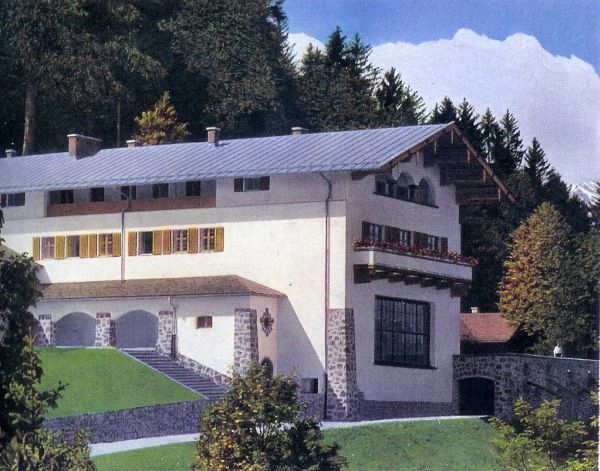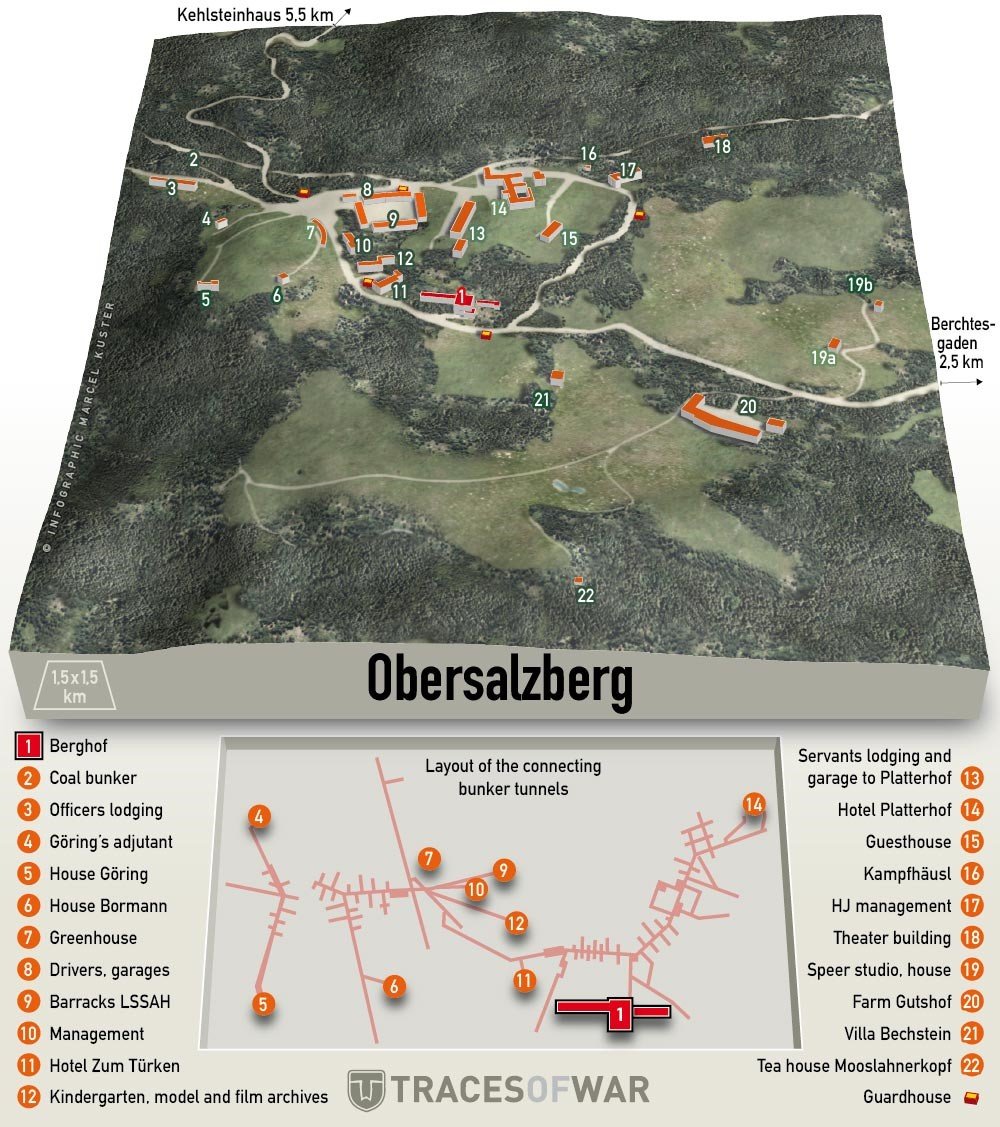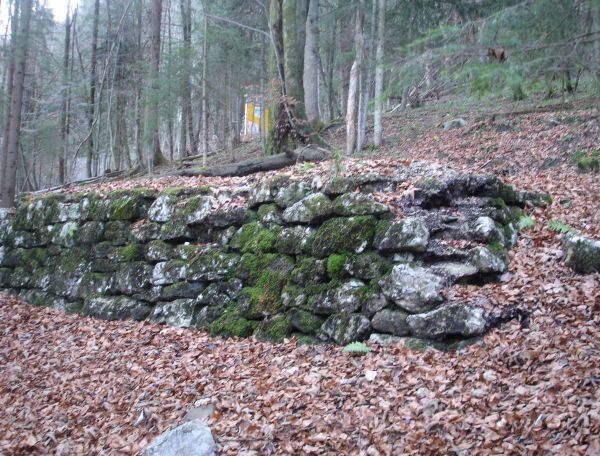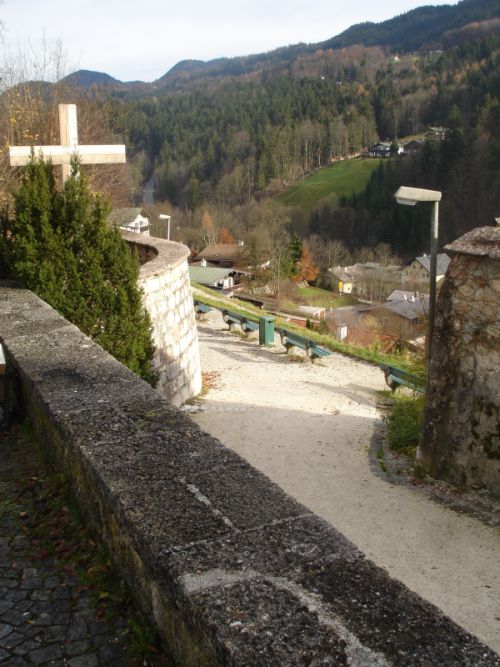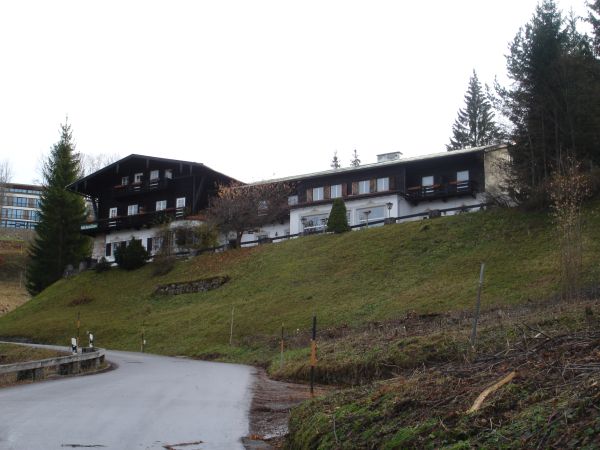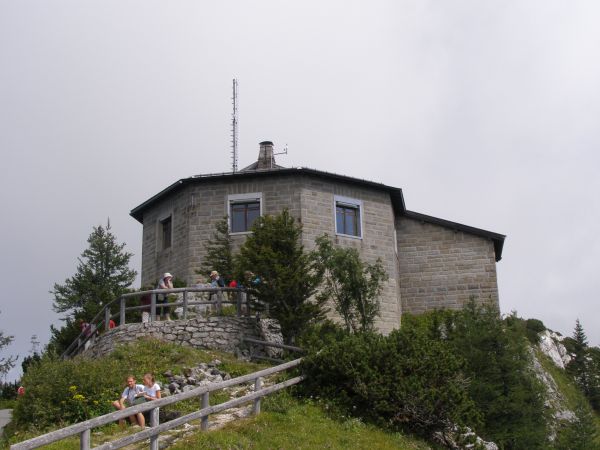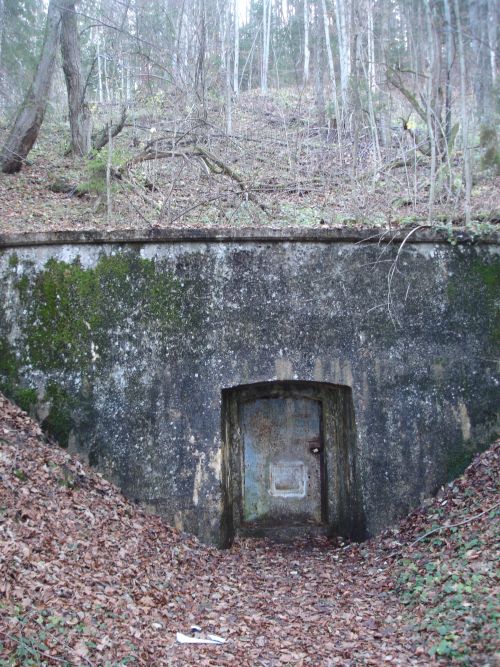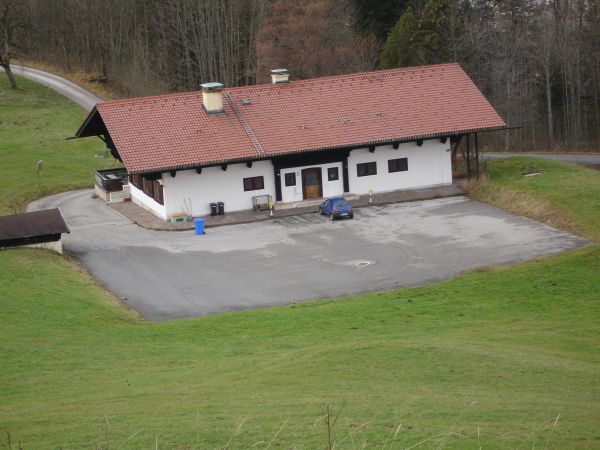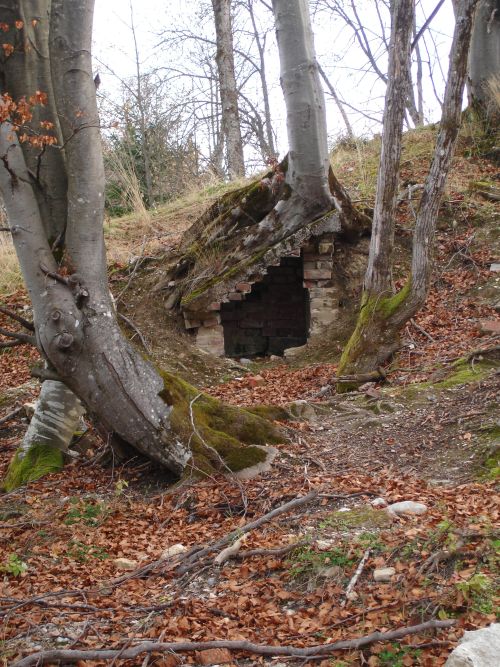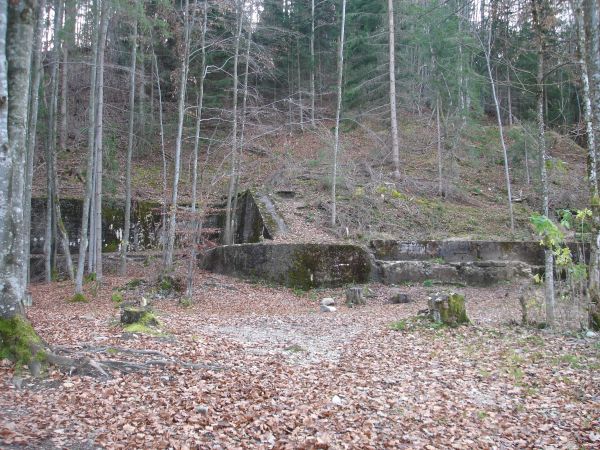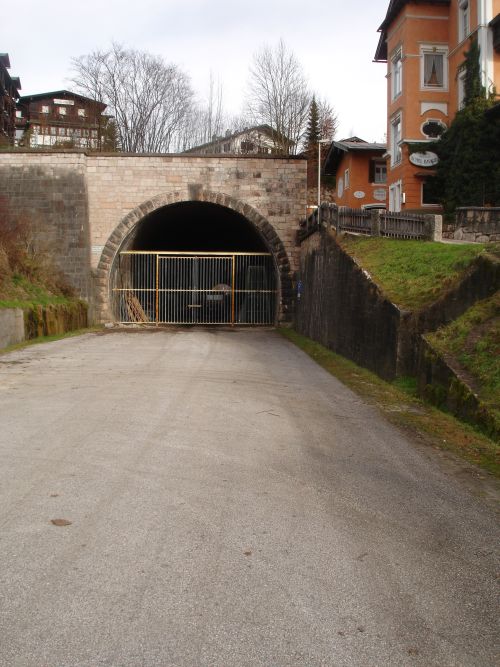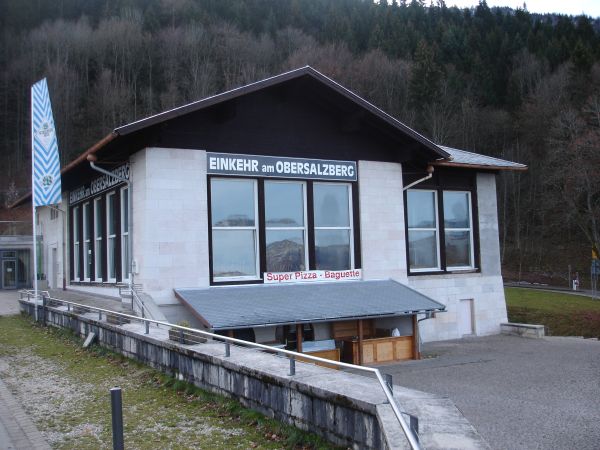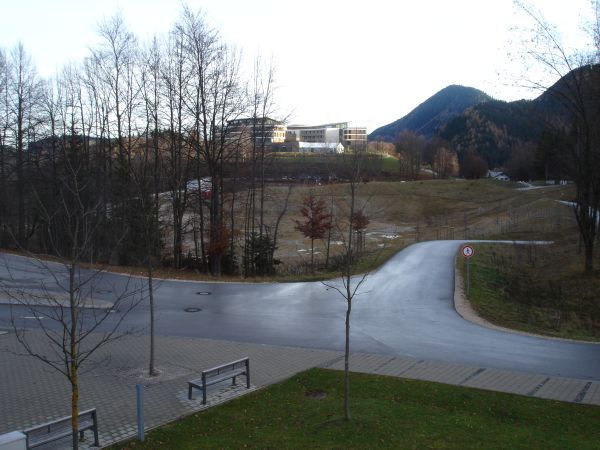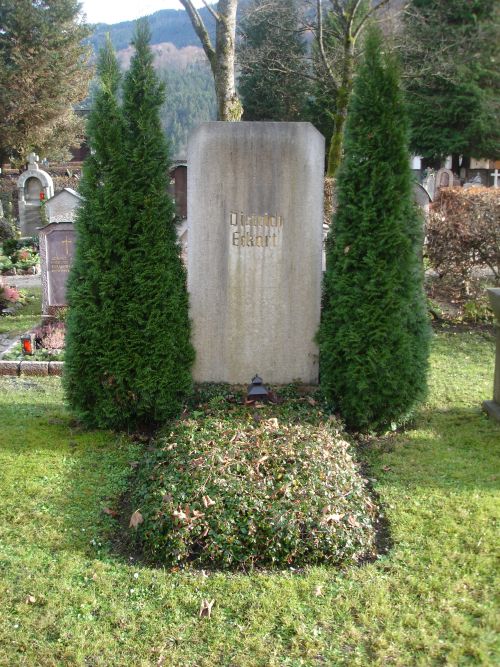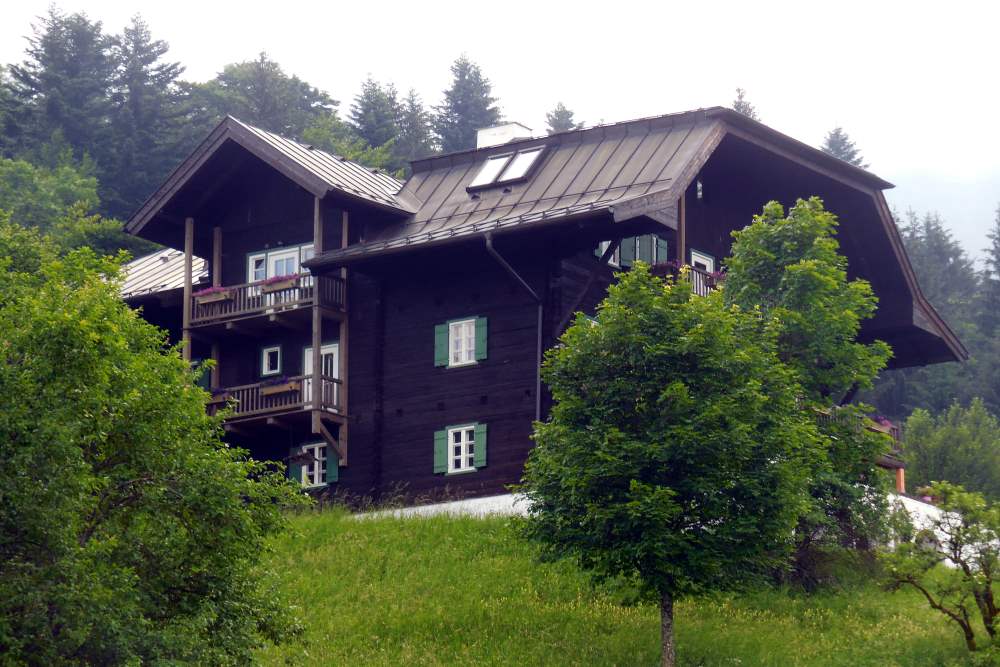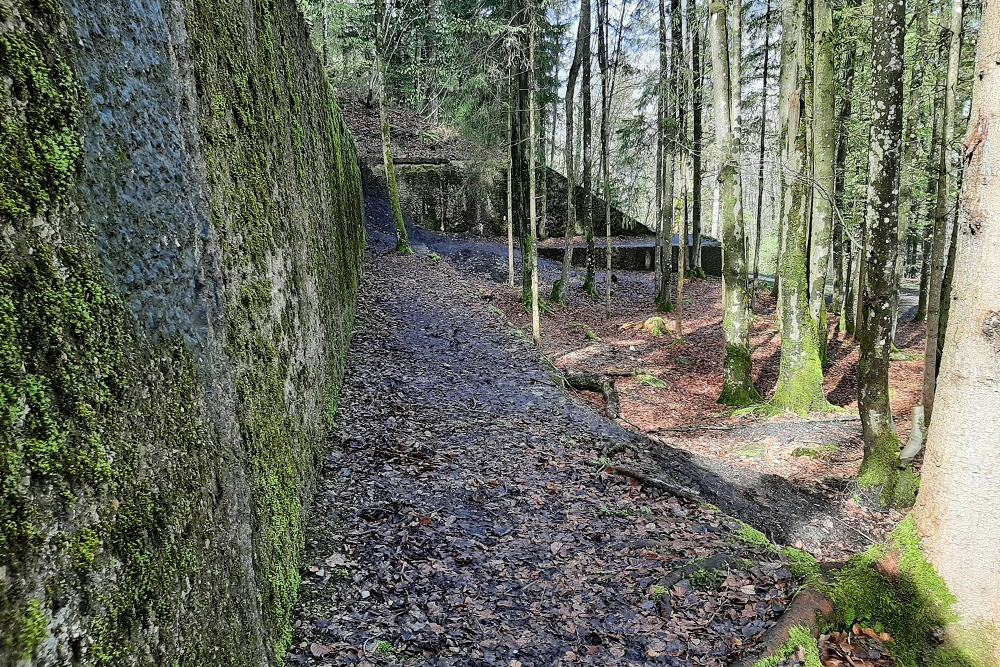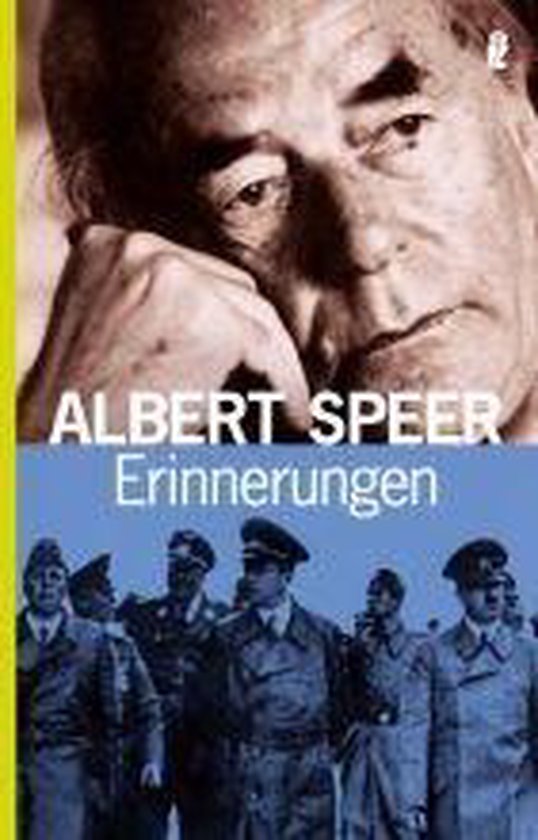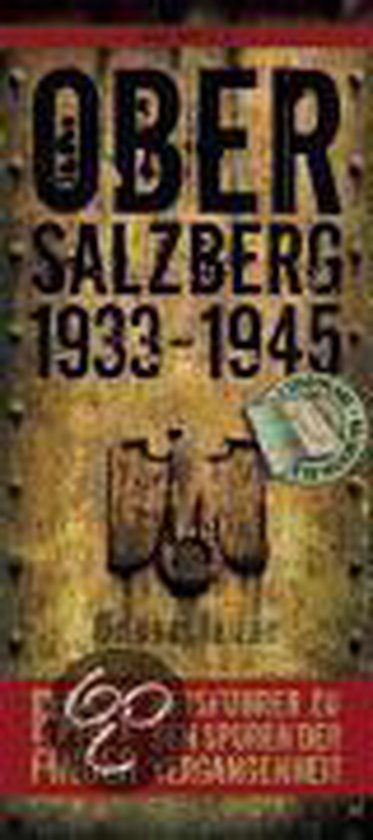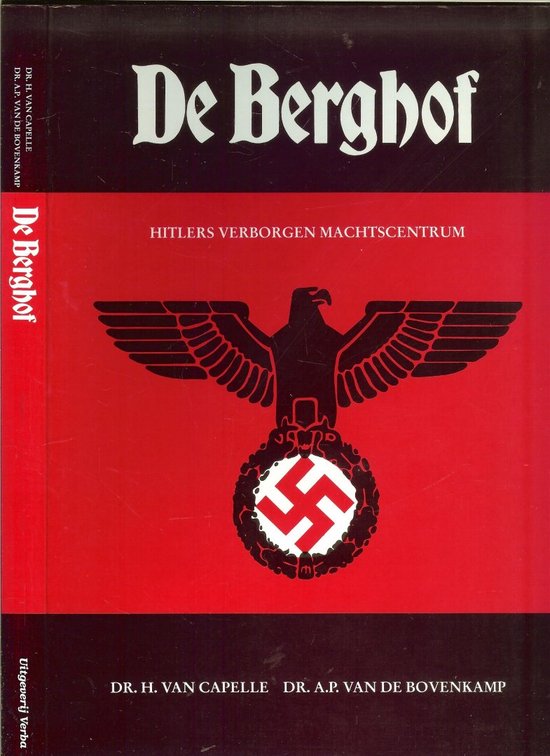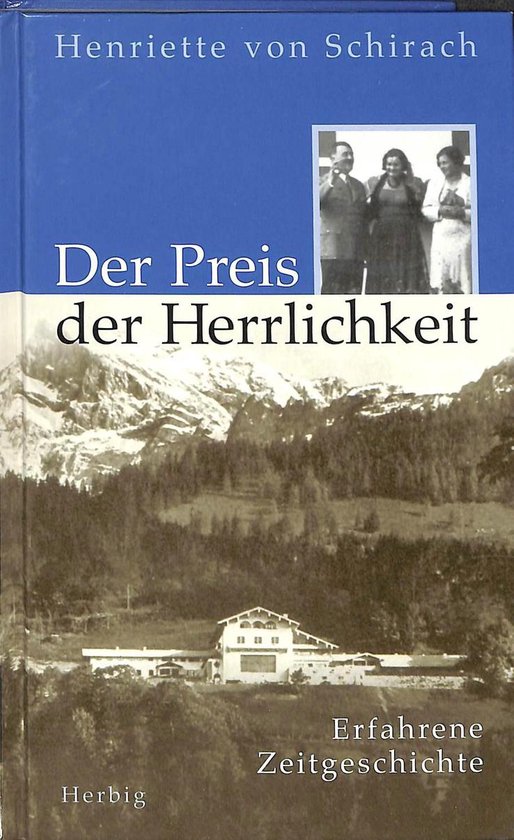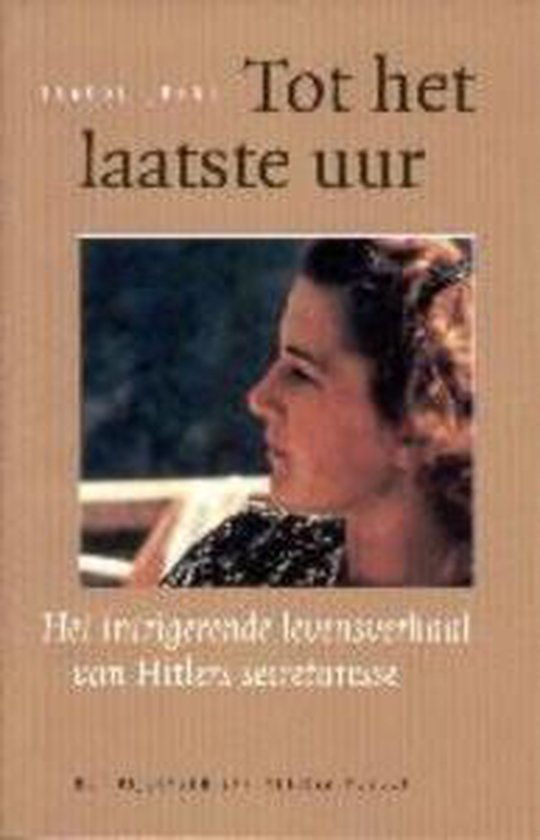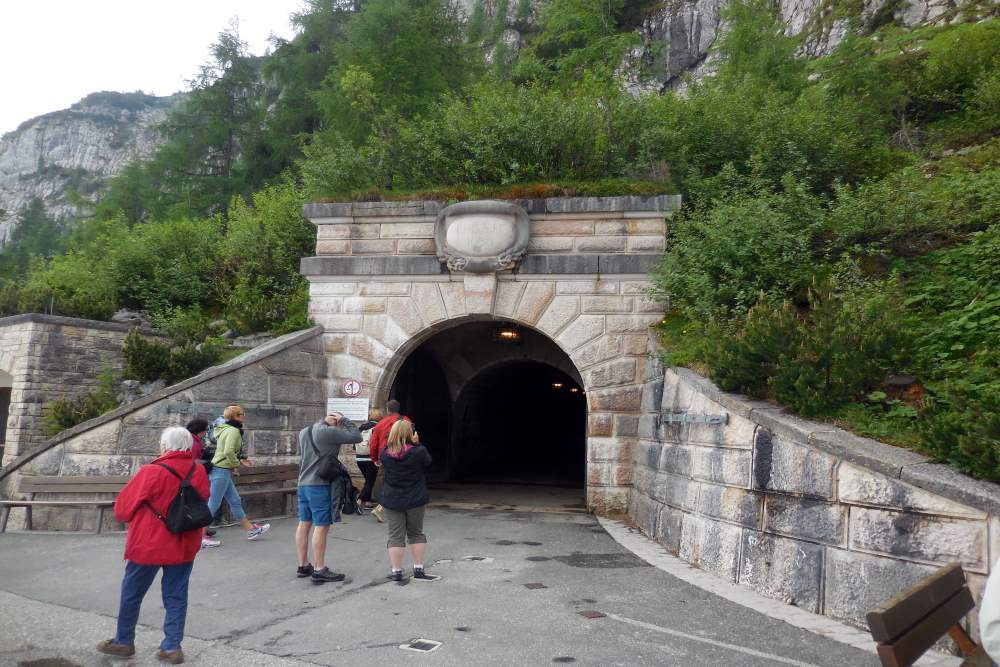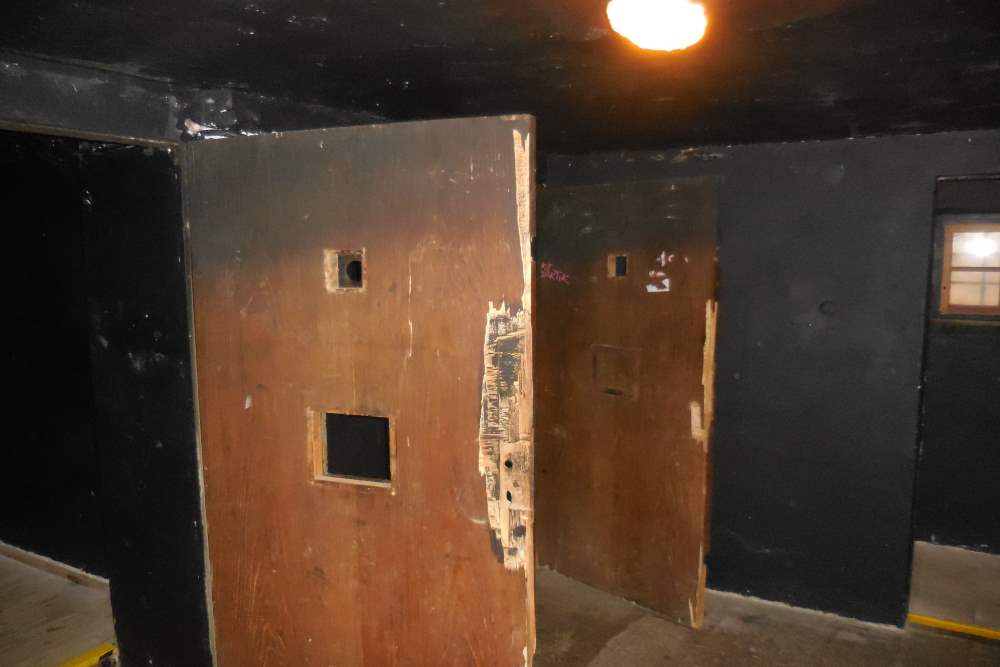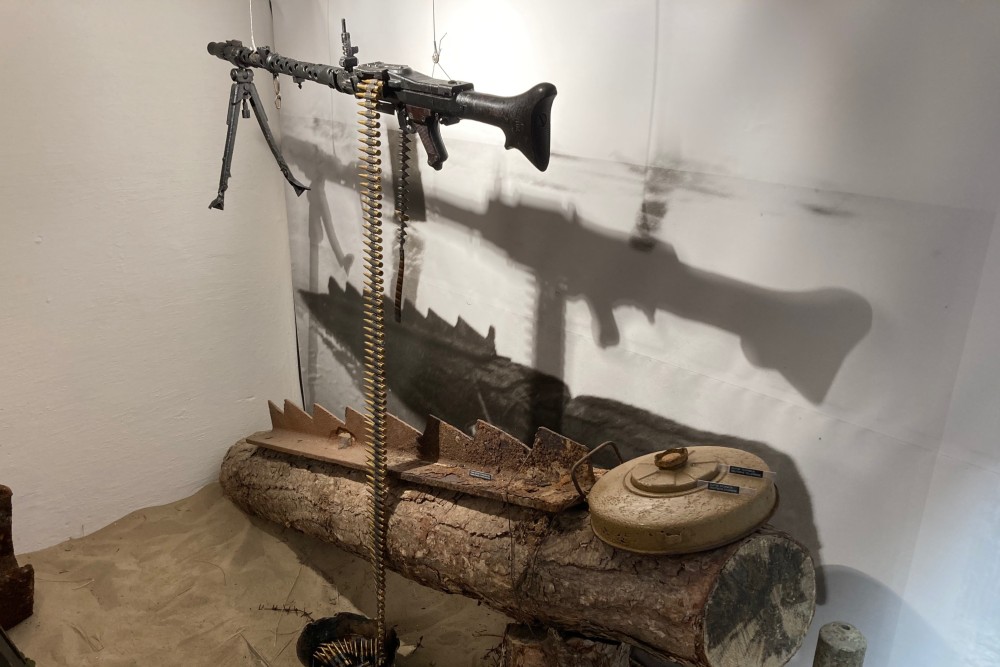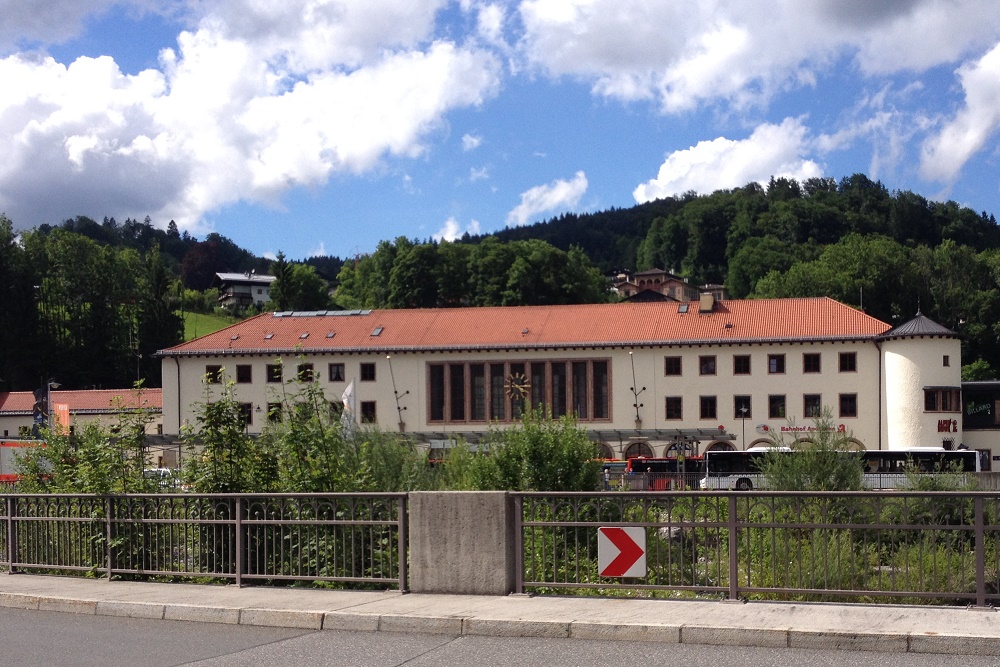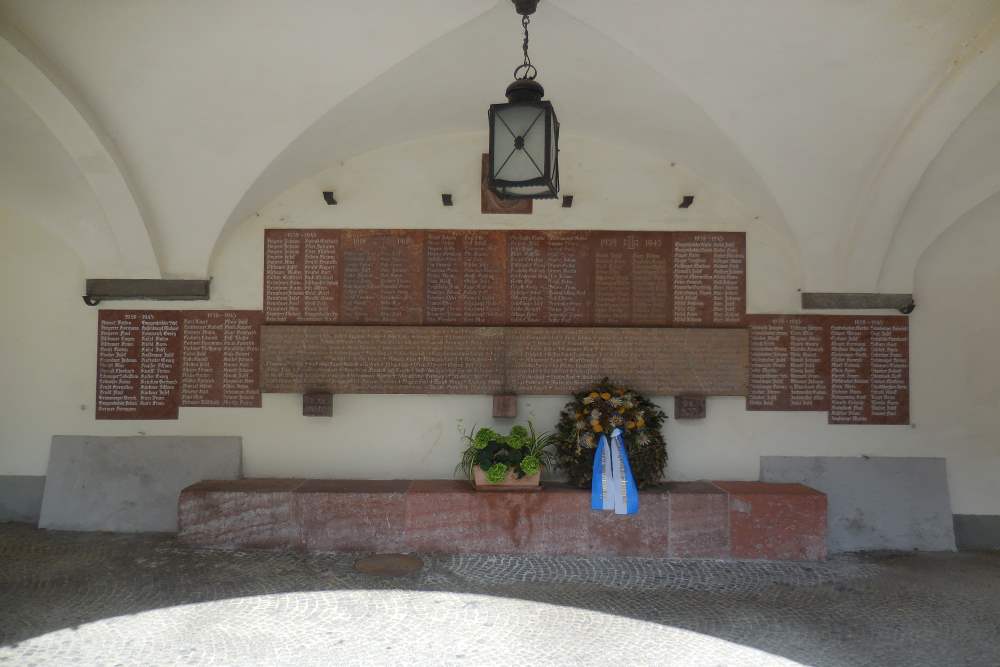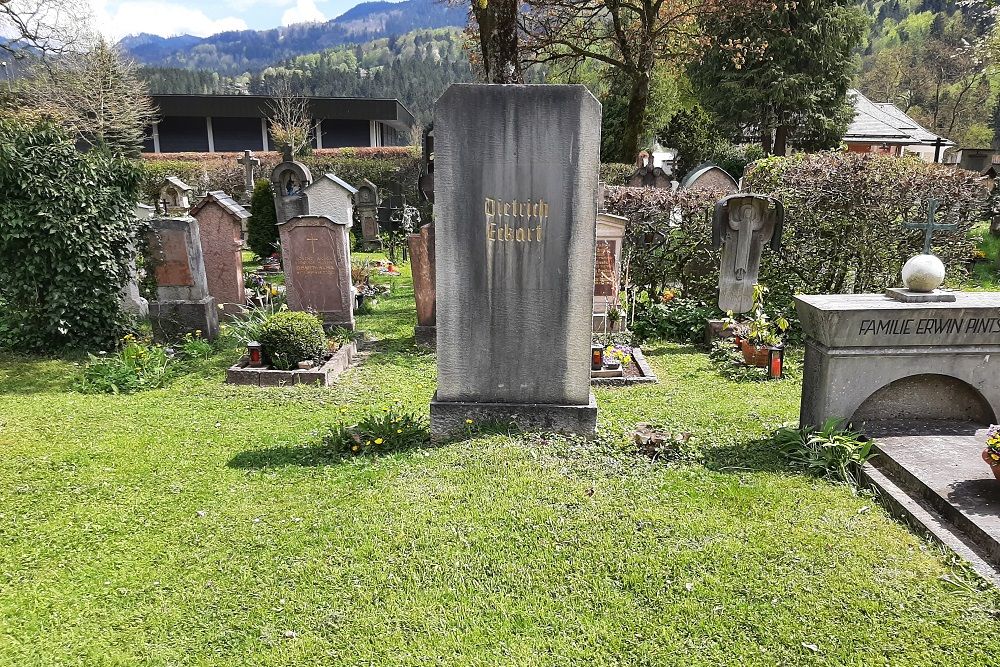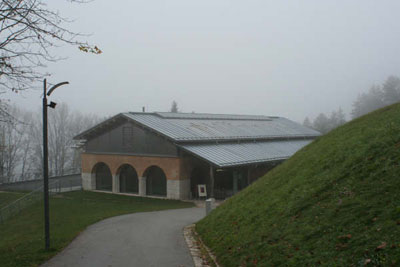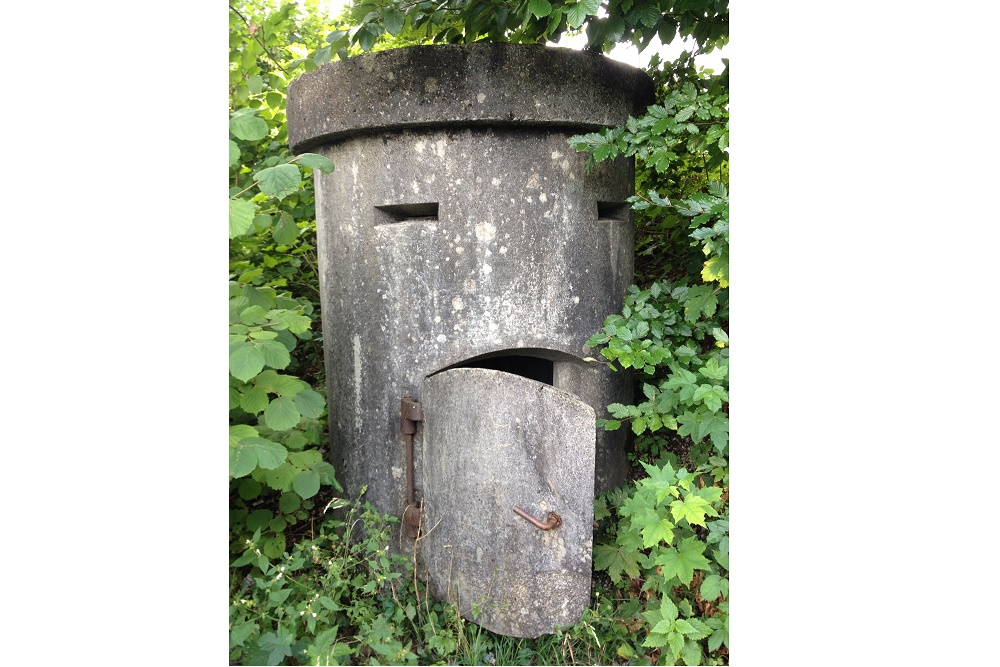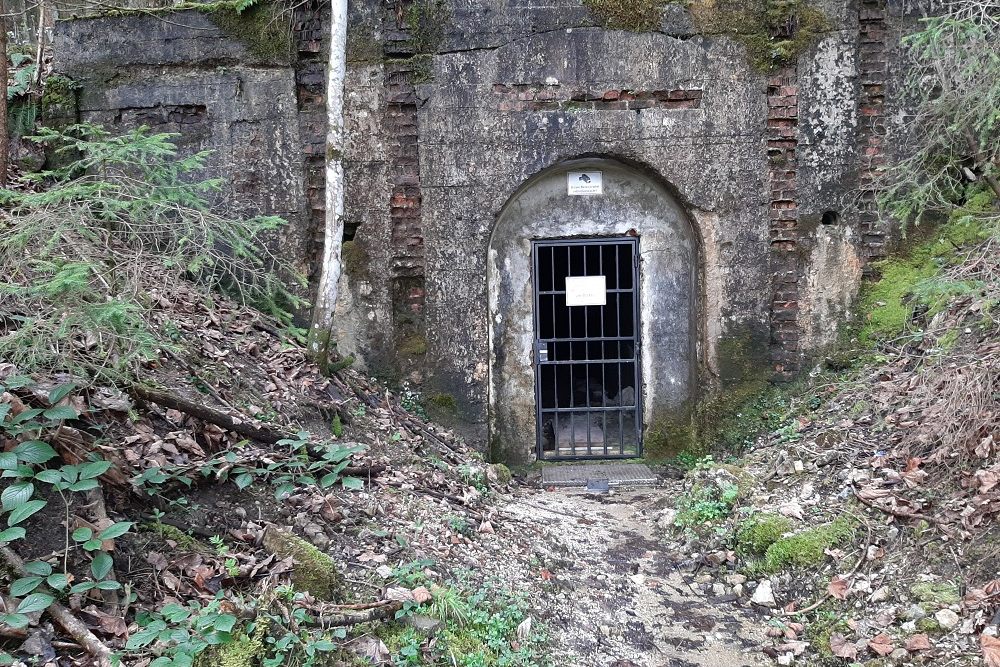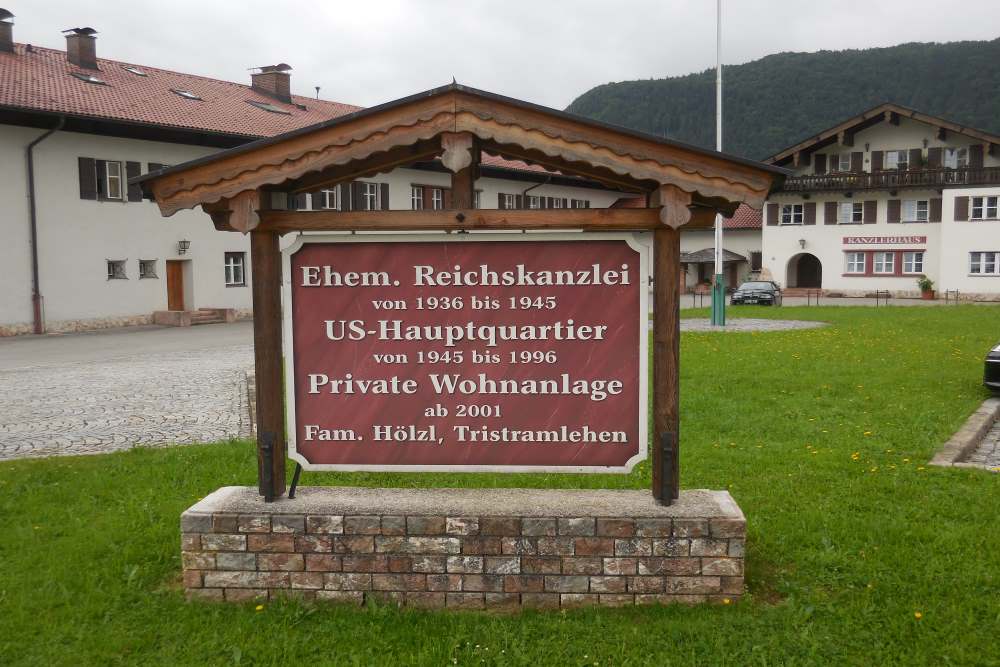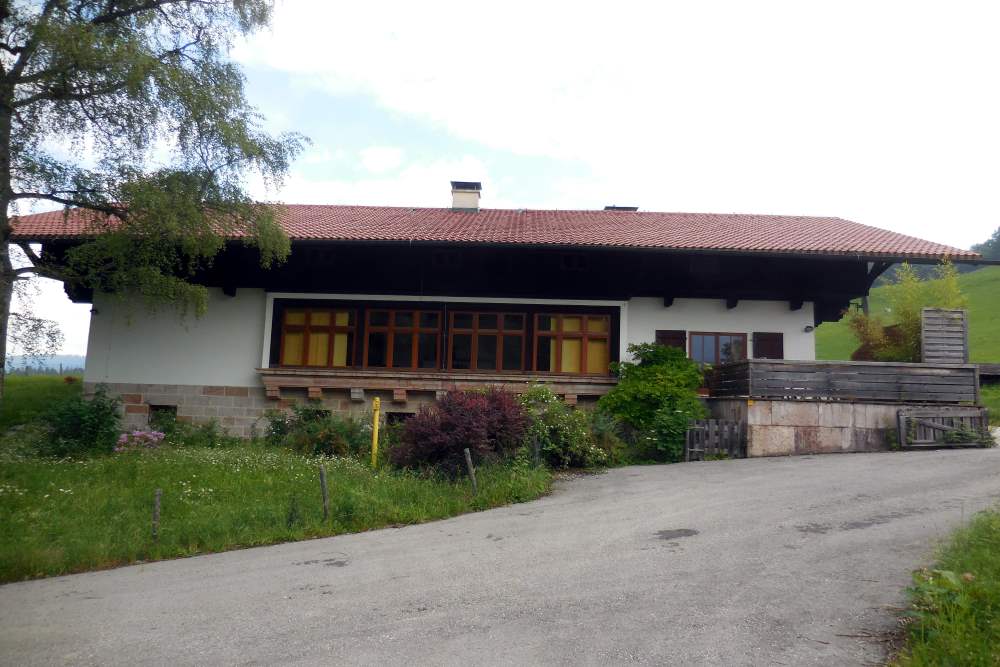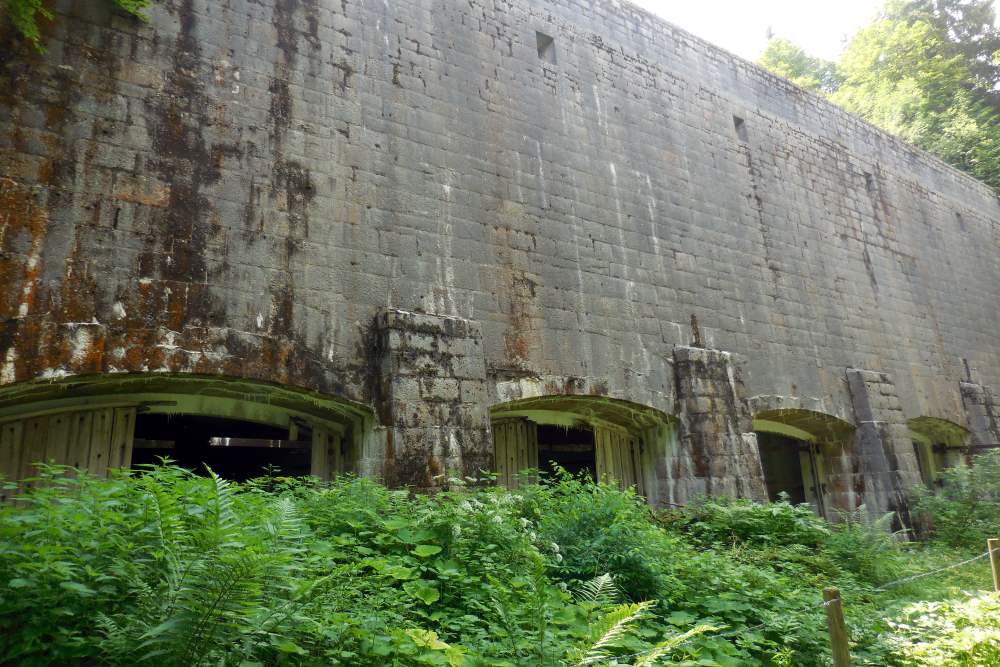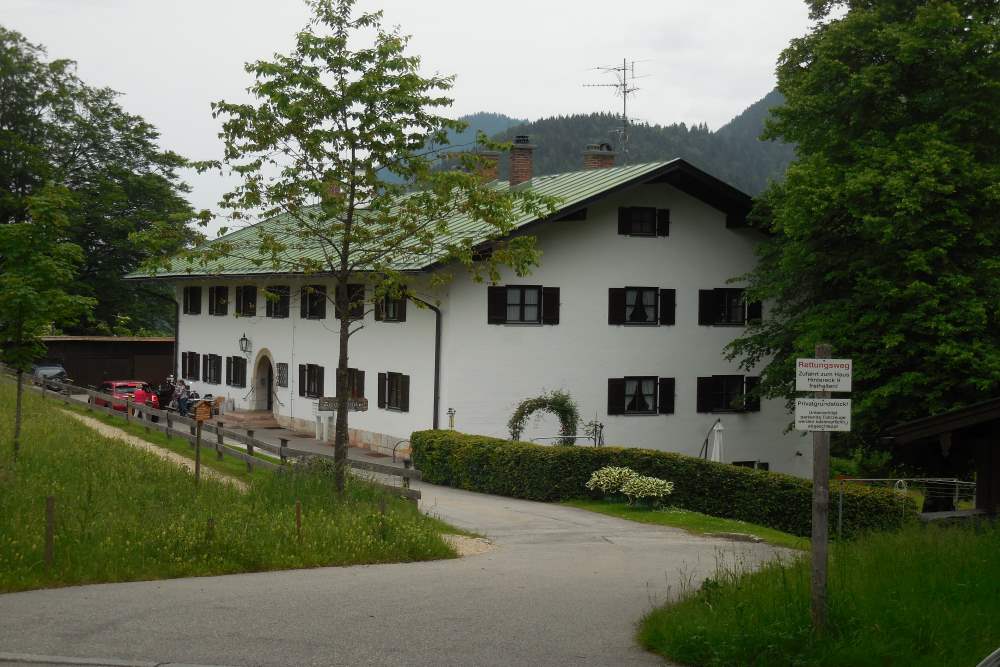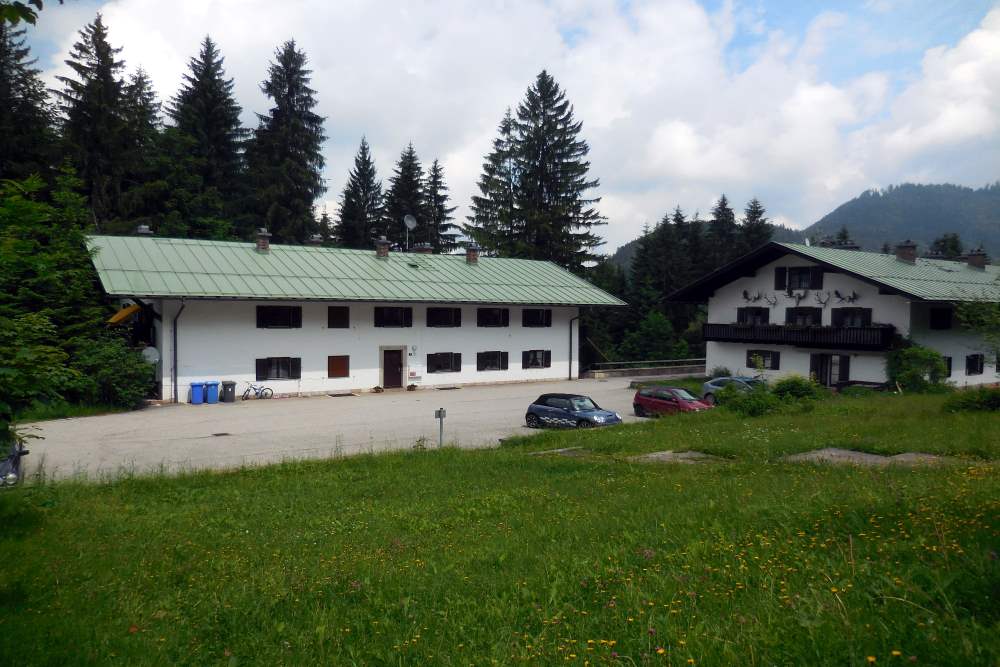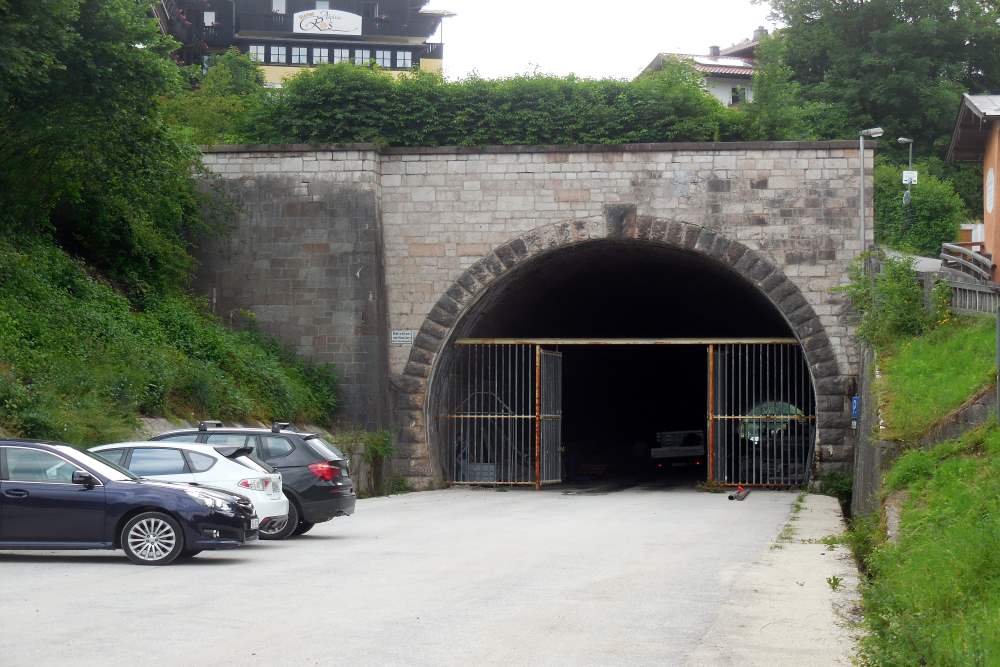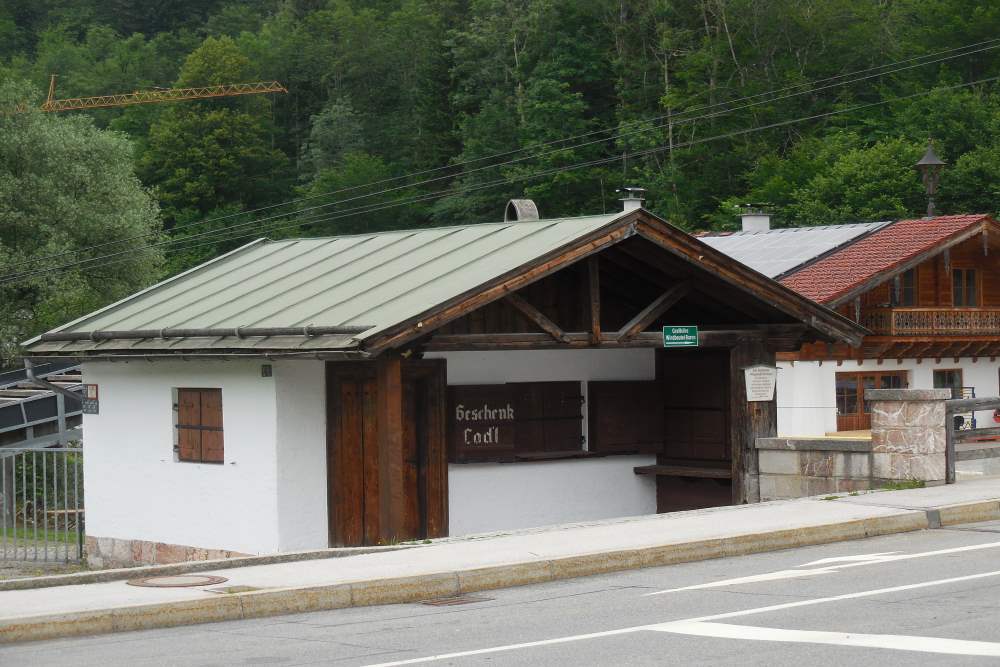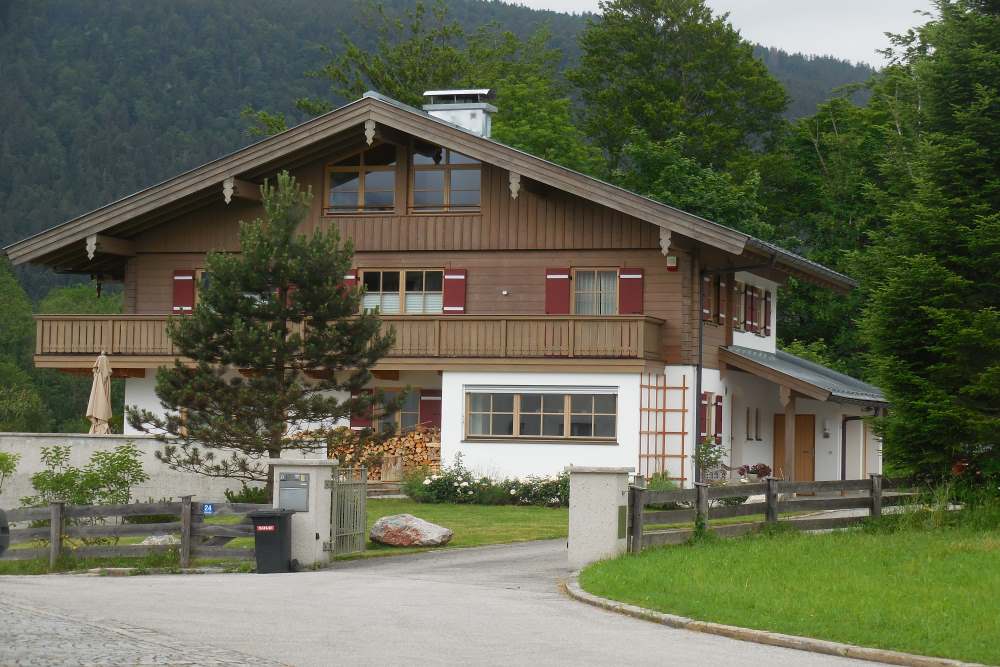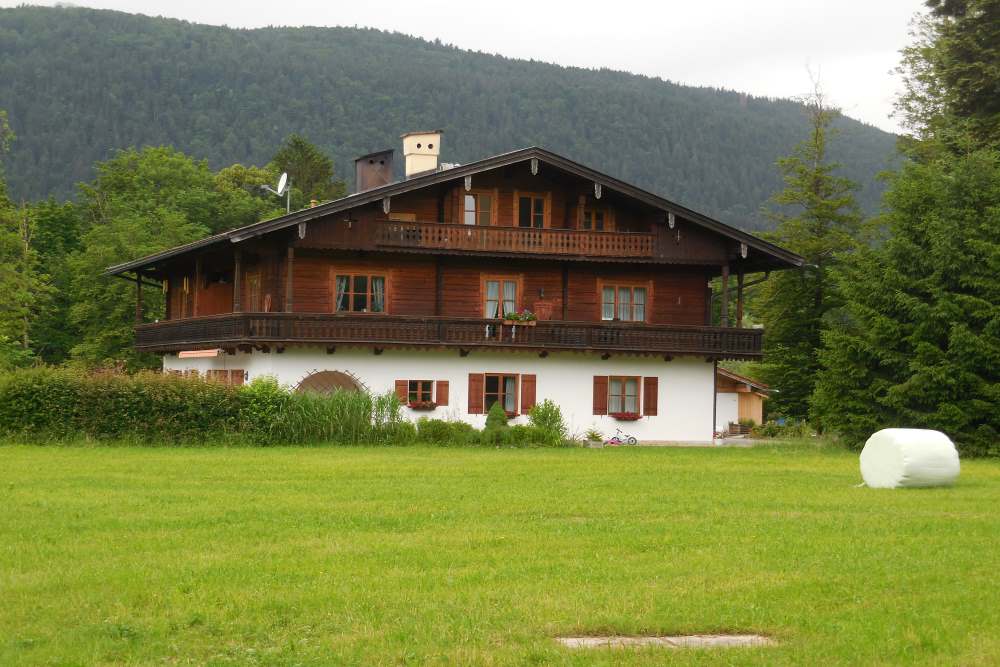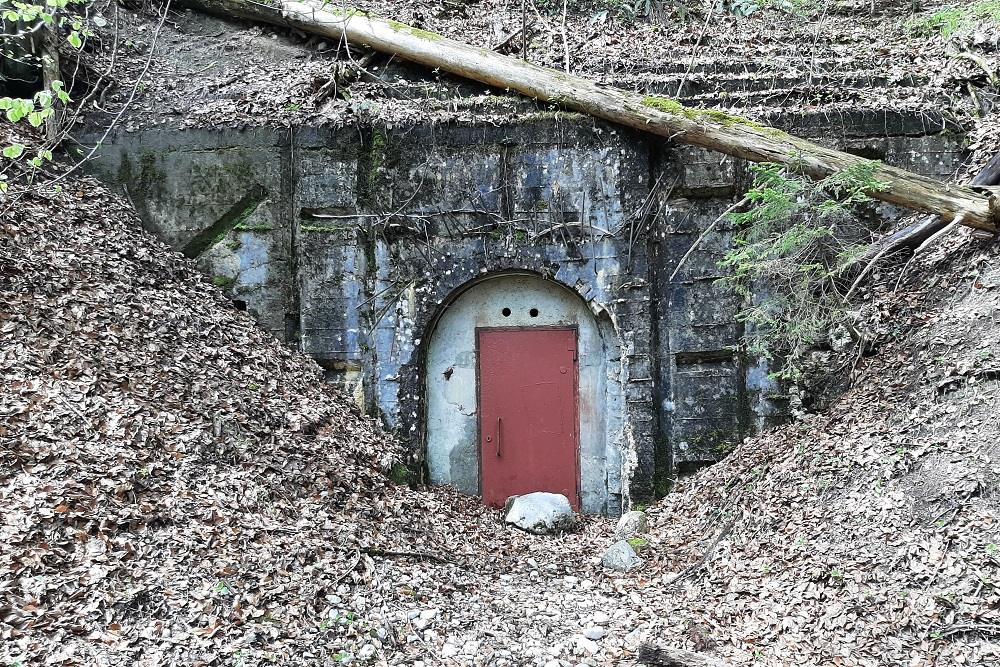Contents
When on 25 April,1945 more than 300 airplanes bombed the Obersalzberg in German Bavaria, the idyllic country resort of Adolf Hitler was finally history. Five days before committing suicide, this last refuge from the bunker in Berlin was closed. But why did the allies bomb the retreat so late in the war? Were they afraid that Hitler would retreat towards the villa at the last moment?
Images
Hitlers introduction into Berchtesgaden
In the winter of 1922-1923, Hitler visited the region of Berchtesgaden for the first time. The Obersalzberg, where he would later have his famous Berghof constructed, was still a quiet mountain with a few farms, a pension and a small hotel, where people could stay in all tranquility. The pension Moritz and the small homes that belonged to the pension were property of Mauritia Moritz, who had bought, in 1877, one of the farms on the mountain in order to convert it into a pension. It would be used on a regular basis in the twenties by Adolf Hitler. Near the pension Moritz and still closer to the hotel Türkenhof that was built in 1911, stood the simple mountain home Haus Wachenfeld that had been built by a merchant from northern Germany.
The poet Dietrich Eckart, who owned a small home in the mountains near the village of Berchtesgaden, introduced Hitler into the region. Eckart functioned in Munich as a sort of mentor of Hitler and he accompanied him when his political aspirations came of age.Together with Hermann Esser, editor of the nazi newspaper Völkischer Beobachter, and Christian Weber, renter of horses and responsible for the security of Hitler, Hitler arrived at the Obersalzberg.That was before 9 November 1923, after a chaotic night in one of the beer cellars of Munich, during which it was tried to overthrow the Bavarian government during the so-called Bierkellerputsch.This coup d'etat failed totally. Sixteen putschists and four police officers died. Hitler fled to Uffing am Staffelsee near Garmisch-Partenkirchen, to the home of the mother of Putzi Hanfstaengl, a former Hitler-sympathizer that would later chose the side of the Americans.Two days later, he was arrested here. Eckart didn't survive the aftermath of the Hitlerputsch. He died in December,1923 in a small home in Berchtesgaden because of a heart attack. Hitler was sentenced to five years in prison because of high treason but would only serve ten months of his sentence in jail.
After Hitler was released from the prison in Landsberg, on 20 December 1924, he kept returning to Berchtesgaden. He liked to walk in the mountains and by doing so he regularly visited the Obersalzberg, a 1,000 meters high mountain. In the spring of 1925 Hitler stayed on the mountain for a longer time. In the so-called Kampfhäusl he met his comrades in arms and he wrote Mein Kampf.The small house belonged to the pension Moritz, but when the owner sold it in 1926 to a new owner that Adolf Hitler did not like for an unknown reason, he moved to the hotel Deutsches Haus in Berchtesgaden. Here he is supposed to have finished writing Mein Kampf. His political friends – Rudolf Hess, Emile Maurice, Heinrich Hoffmann and Joseph Goebbels – were there on a regular basis. In their spare time they drove through the mountains together or went to the Königssee for a boat trip. In the spring of 1926 the 37-years old Hitler stayed in the hotel Deutsches Haus again. In the Kurpark of Berchtesgaden he saw a girl playing with her dog, an Alsatian. Hitler introduced himself to the 16-year old girl, Maria (Mimi) Reiter. The girl, that must have been in a difficult time because her mother had passed away shortly before, turned out to be sensitive for Hitlers flirting and a short romance developed.Together they rode in the surrounding area and the girl fell in love with Hitler, who however didn't want to be involved seriously. He hadn't got time for that anyway. He was much more busy with his political future than with the love of Mimi.The relation ended in a drama. After that Hitler didn't visit her for a long time it came so far that she tried to commit suicide. Her brother- in- law found her just in time to save her. Hitler's preference for much younger women, who according to him were much easier to mold, would continue in his relations with his niece Geli Raubal and Eva Braun. Whether the young Geli Raubal had a real relationship with her uncle remains not entirely clear, but she also tried to commit suicide under the influence of Hitler in Munich. Her attempt succeeded. Eva Braun, who was almost 23 years younger than Hitler, attempted to commit suicide twice on moments that he had little attention for her.
Definitielijst
- Berghof
- A villa hidden deep in the Alps built at the top of the Obersalzberg near Berchtesgaden. This villa was property of Hitler and centre of the ”Alpenfestung”. The villa has an enormous complex of tunnels with a length of nearly 11 km. From the Berghof the Third Reich was ruled by Hitler and his close companions. Eva Braun, Hitler’s companion, spent a lot of time there.
- Mein Kampf
- “My Struggle”. Book written by Adolf Hitler, outlining the principles of National Socialism.
- nazi
- Abbreviation of a national socialist.
Images
Haus Wachenfeld and the Berghof
When Hitler returned to the Obersalzberg in the summer of 1928, he dictated his so called Second Book to his publisher and war comrade Max Amann. The book would never be published because the sale of the second part of Mein Kampf did not go well. Amann likely understood that the Second Book would become an unwanted competitor of Mein Kampf. Furthermore, already in 1929, it appeared that revision of the manuscript would be necessary. For example because Gustav Stresemann, who was portrayed as a big enemy in the book, passed away in that year.
In 1928, Adolf Hitler rented for the first time Haus Wachenfeld, where he stayed after the elections of 1928. His stepsister, Angela, became responsible for the housekeeping. Until Hitler, as new Chancellor of Germany, bought Haus Wachenfeld in 1933, little changed. Hitler used the house as a holiday resort and also the summer of 1933 was spent for the largest part at the Obersalzberg. He received many nazi bosses and personal friends there.The photographer Heinrich Hofmann was there with his wife, as well as private driver and SS-man Julius Schreck, chief of press Otto Dietrich, adjutant Julius Schaub, swimming champion and fiancee of Hitler's court- physician Dr.Karl Brandt, Anni Rehborn, and Eva Braun. Many of the guests still had to stay in one of the pensions in the vicinity, because the Berghaus was too small to accomodate all these guests.
Although the stream of tourists began to grow, Hitler could still stroll around the mountain in a reasonably undisturbed way.
In this way, he would occasionally stroll to the Gasthof Hochlenzer, where the sun could be enjoyed on wooden seats. Later, the walks would become less varied and Hitler and his company eventually only would frequent the Tea House on the Mooslahnerkopf.
Because large numbers of tourists came to the Obersalzberg to watch Hitlers house and the Führer himself, traffic measures had to be taken in the summer of 1933. On certain days around 5,000 people were lining up in order to be able to walk past house Wachenfeld. And sometimes they were lucky: Hitler would come outside sometimes. Eventually the direct surroundings of Haus Wachenfeld became the first and the best protected zone of the 'Führersperrgebiet', so that it became increasingly difficult to get inside.
In 1935, when Hitler did well financially, it was decided to renovate the simple Haus Wachenfeld into a representative home that was also suited to accomodate more guests. Hitler personally designed the house and architect Roderick Fick executed the ideas.The only thing that vanished from the old house was the exterior, the rooms themselves were integrated in the new villa, the Berghof: Hitlers mansion with the enormous window and the famous stairs on which later many national and international guests were received.
In the village of Berchtesgaden at the foot of the Obersalzberg various adaptations were necessary after 1933. Because of the many tourists that wanted to see the Führer, the train transport to the village increased immensely and therefore it was needed to build a new and bigger station.. The hotel Berchtesgadener Hof, which was more a spa, was rebuilt into a luxurious hotel. It was used by important guests of Hitler, like Neville Chamberlain, Benito Mussolini, Joseph Goebbels, Joachim von Ribbentrop, Heinrich Himmler and Erwin Rommel. Also later, a lot was constructed around the surroundings of Berchtesgaden, like a second Reichskanzlei in Stangass, a youth hostel(the Adolf-Hitler youth hostel), a sport school for the Bund Deutscher Mädel, a barracks for the Gebirgsjäger-Regiment, the Dietrich-Eckart-hospital and near Salzburg, a small airfield was constructed.
Definitielijst
- Berghof
- A villa hidden deep in the Alps built at the top of the Obersalzberg near Berchtesgaden. This villa was property of Hitler and centre of the ”Alpenfestung”. The villa has an enormous complex of tunnels with a length of nearly 11 km. From the Berghof the Third Reich was ruled by Hitler and his close companions. Eva Braun, Hitler’s companion, spent a lot of time there.
- Führer
- German word for leader. During his reign of power Adolf Hitler was Führer of Nazi Germany.
- Mein Kampf
- “My Struggle”. Book written by Adolf Hitler, outlining the principles of National Socialism.
- nazi
- Abbreviation of a national socialist.
- Regiment
- Part of a division. A division divided into a number of regiments. In the army traditionally the name of the major organised unit of one type of weapon.
Images
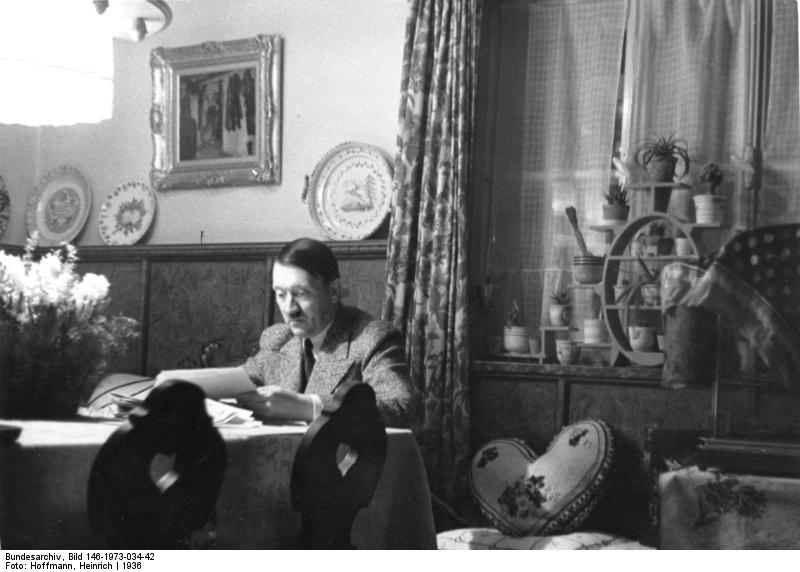 Hitler in the old house Wachenfeld Source: Bundesarchiv, Bild 146-1973-034-42 / Heinrich Hoffmann / CC-BY-SA 3.0.
Hitler in the old house Wachenfeld Source: Bundesarchiv, Bild 146-1973-034-42 / Heinrich Hoffmann / CC-BY-SA 3.0.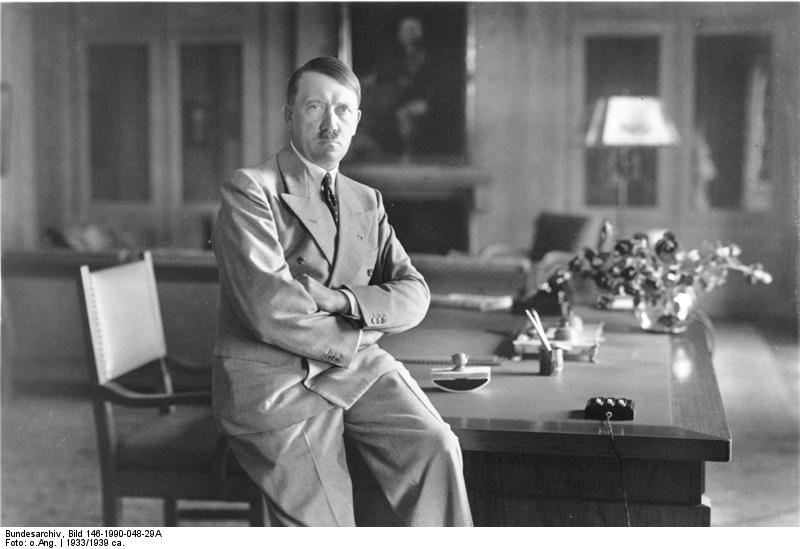 Hitler in the study of Berghof in 1936 Source: Bundesarchiv, Bild 146-1990-048-29A / Heinrich Hoffmann / CC-BY-SA 3.0.
Hitler in the study of Berghof in 1936 Source: Bundesarchiv, Bild 146-1990-048-29A / Heinrich Hoffmann / CC-BY-SA 3.0.Building master
Martin Bormann was responsible for the building activities at the Obersalzberg. After having pressured the original inhabitants, Bormann bought up all kinds of farms in the vicinity and had them demolished. After 1933, around 50 dwellings and farms were demolished in order to make room for the buildings of Bormann and Hitler. The original inhabitants mostly received a meagre compensation. Whoever did not want to leave was pressured, for example by cutting electricity wires. In this way the mountain was slowly shaped according to Hitlers wishes. He only had to give a small hint and Bormann would mobilize anything to accomodate him. A typical example of this, what Hitler biographer Ian Kershaw called, 'working towards Hitler', is the story of the Hitler tree. After Hitler stood in the sun for an extended period, while a long file of admirers passed by, he was supposed to have said that he was death- tired from standing in the sun. One day later on that same spot of the drive to the Berghof a large tree stood there, placed on orders of Bormann. Even a stronger case was when Hitler said one time that he found it a pity that the view from the terrace of the Berghof was disrupted by an old farm. Just a bit more than a day later that farm had vanished entirely.
Bormann was a fanatic "building master". In the thirties, the mountain seemed more an excavation than an idyllic mountain resort. Around one kilometer from the Berghof, lay a large camp of barracks for labourers- after the start of the war also Czech, Polish and Slovak forced labourers- that were needed to realize Bormanns plans, including a cinema with 2,000 seats. When Bormann was annoyed by something, this could have direct major consequences. He sent, when the work wasn't to his taste, complete building firms home. Under his pressure the builders achieved enormously. On 1 July 1937, he formulated the use of his frequent visits to the site as follows: 'As much as possible daily inspections of the construction sites. Exhorting, exhorting!'
The Obersalzberg became the private domain of the Führer: a terrain where only he himself lived together with a number of nazi friends.The region was divided into three zones, the so called 'Sperrkreise'. The Berghof and the direct vicinity were in the first zone that was hard to get into. Underneath, on the border of the second zone, for example at the edge of Berchtesgaden, all roads that led to the Führer area were guarded. Eventually, so many SS men were needed that a complete new barracks was constructed. Hotel Türkenhof, that lay next to the Berghof, became the headquarters of the guarding activities of the Gestapo and the SS. The third guarded zone included the whole Kehlstein-region.
Further, Bormann had one of the outbuildings of the pension Moritz converted into a local party chancellory so that the contact with the party headquarters in Munich would be easier. The building-not to be confused with the second chancellory in the village of Stangass – was also used as a guest house after the reconstruction.
Bormann had a modern farm realized on the mountain, the Gutshof, that was to be a model for other farms in the Greater German Reich. And near Bormann's own house, a large glass house was built where mainly flowers were grown. When the glass house was destroyed at the end of the war during a hail storm, Bormann had this restored and even expanded. In the rest of Germany this kind of luxury was seen as a waste, at a moment when austerity was demanded from everyone, but on the Obersalzberg this kind of matters fell under the 'Sonderbauprogramm des Führers', the "special building program of Hitler".
The old pension Moritz was replaced by the new hotel the Platterhof. Bormann, however, interfered so intensely with the building that entire parts that had already been finished were broken down again and rebuilt. In order to proceed with the building of the hotel in 1939, after the start of the war, Bormann placed the Platterhof even under the 'Kriegwichtiges Bauprogramm des Führers', the building program of Hitler important for the course of the war. Building the hotel in wartime wasn't so important obviously; this was a handy way to get money in the right direction without critical questions being asked. The hotel, that was once meant to be a hotel where every German could spend a night near his Führer for a Reichsmark, got such a size and became so luxurious that the average man couldn't afford a stay in the hotel. Only high ranking nazis used the hotel. The ordinary people could only stay in the cafe the Bergschränke, near the motel.The Platterhof only served shortly as a hotel. Because of the war it was used as a military hospital already in 1943.
Definitielijst
- Berghof
- A villa hidden deep in the Alps built at the top of the Obersalzberg near Berchtesgaden. This villa was property of Hitler and centre of the ”Alpenfestung”. The villa has an enormous complex of tunnels with a length of nearly 11 km. From the Berghof the Third Reich was ruled by Hitler and his close companions. Eva Braun, Hitler’s companion, spent a lot of time there.
- Führer
- German word for leader. During his reign of power Adolf Hitler was Führer of Nazi Germany.
- nazi
- Abbreviation of a national socialist.
Images
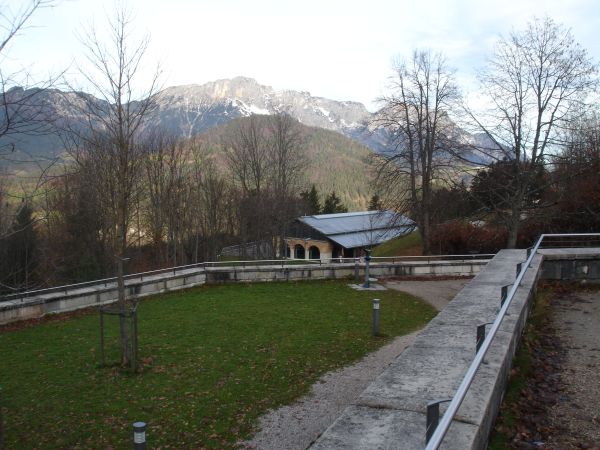 The Parteikanzlei and Gästehaus from Bormann is now rebuilt into a documentary centre on the Obersalzberg Source: Sjoerd de Boer.
The Parteikanzlei and Gästehaus from Bormann is now rebuilt into a documentary centre on the Obersalzberg Source: Sjoerd de Boer.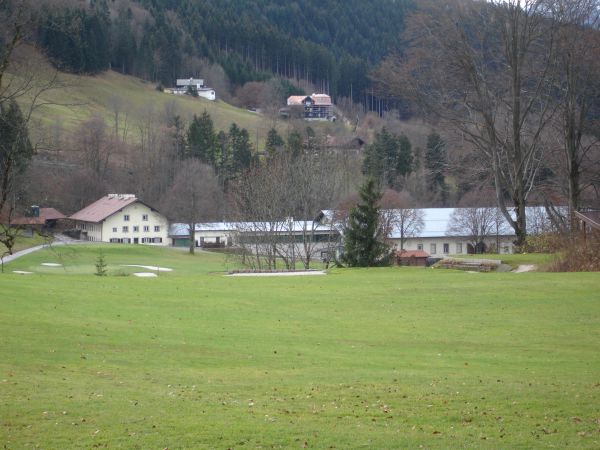 The Gutshof and, in the middle in the background, the house of Albert Speer. His workplace is hidden behind the trees Source: Sjoerd de Boer.
The Gutshof and, in the middle in the background, the house of Albert Speer. His workplace is hidden behind the trees Source: Sjoerd de Boer. The final check for the visitors of the Obersalzberg took place at this guard house.The Berghof can be seen on the background Source: Bundesarchiv, Bild 183-1999-0412-502 / CC-BY-SA 3.0.
The final check for the visitors of the Obersalzberg took place at this guard house.The Berghof can be seen on the background Source: Bundesarchiv, Bild 183-1999-0412-502 / CC-BY-SA 3.0.The Kehlsteinhaus
On the Obersalzberg two more luxurious buildings were established further in 1942-1943: the Klausenhöhe and the Buchenhöhe. But the most famous and prestigious building was the Kehlsteinhaus.
The Kehlsteinhaus lay at 1,834 meters, and was intended to impose on the guests of the Führer. The view towards there was amazing but also the road leading to the place was impressive. The construction alone of the road cost more than two years. At the end of the road was a parking lot near a large gate in the mountain. Behind the gate there was a 130 meters long corridor that led to an elevator. With that elevator one could reach the Kehlsteinhaus. The project cost 30 million Reichsmark. Although Bormann had the house built especially for Hitler, he did not visit that much. It seems that there was something about the height or the elevator that Hitler did not like. Hitler received a few guests in the Kehlsteinhouse, among who André François-Poncet, who said goodbye in 1938 as ambassador of France. The marriage of Gretl Braun, the sister of Eva Braun, and Hermann Fegelein on 3 June 1944, was celebrated in the Kehlsteinhaus.
In 1943, construction of air raid shelters under the houses on the Obersalzberg began, because the allies progressively gained air supremacy in the skies over Germany. Under responsibility of the architect Hermann Giesler, a network of corridors and bunkers was constructed. There were rooms for Hitler, for Eva Braun, for court- physician Dr. Theodor Morell, kitchens and pantries and rooms for Hitler's body guards. In order to be prepared for everything, the pantries were lavishly filled with food and drinks.The system of corridors was never entirely finished, but from most buildings and houses one could reach the bunkers. Also under Görings mansion there was a bunker, but this was not connected to the larger network that lay under the Berghof.
At the end of all these construction works, one could not really consider the mountain a silent retreat. Hitler said therefore once, according to Speer, that when all would be over, he would once more pick a silent valley to build a house like in the beginning...
Definitielijst
- Berghof
- A villa hidden deep in the Alps built at the top of the Obersalzberg near Berchtesgaden. This villa was property of Hitler and centre of the ”Alpenfestung”. The villa has an enormous complex of tunnels with a length of nearly 11 km. From the Berghof the Third Reich was ruled by Hitler and his close companions. Eva Braun, Hitler’s companion, spent a lot of time there.
- Führer
- German word for leader. During his reign of power Adolf Hitler was Führer of Nazi Germany.
- raid
- Fast military raid in enemy territory
Images
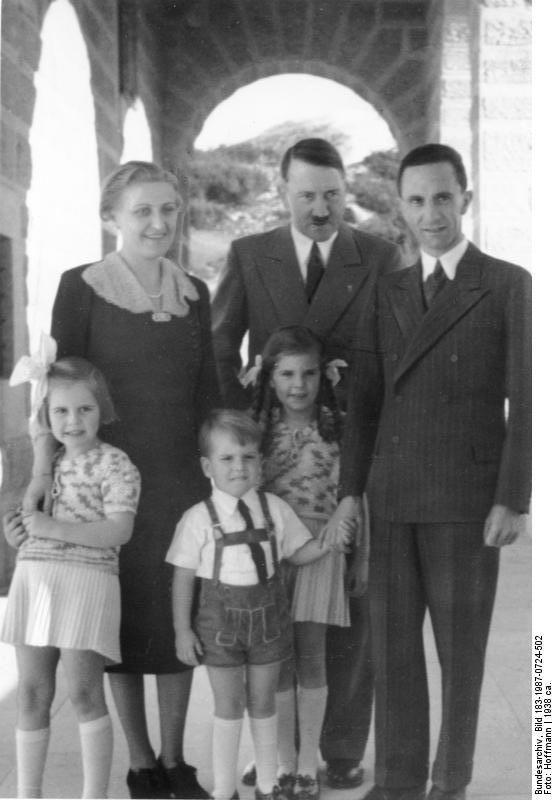 The Goebbels family with Hitler in the Kehlsteinhaus Source: Bundesarchiv, Bild 183-1987-0724-502 / Heinrich Hoffmann / CC-BY-SA 3.0.
The Goebbels family with Hitler in the Kehlsteinhaus Source: Bundesarchiv, Bild 183-1987-0724-502 / Heinrich Hoffmann / CC-BY-SA 3.0.Friends of the Führer
A number of political friends of Hitler's had a house on the mountain. Hermann Göring already had a house there in 1933. His house lay behind the house of Martin Bormann and just higher than the Berghof, on what quickly became known as the Göring hill. Hitler did not mind that Göring had his house renovated. He did that several times, but he took care that the luxurious villa, the only one with a swimming pool, did not get bigger than the Berghof. Near the house lay the so called Adjudantur, that was needed for the Luftwaffe. Adjutant general Karl Bodenschatz and his staff used this building to live and work in, so that Göring was well informed even when he stayed at the Obersalzberg. Görings family stayed at the mountain for a considerable part of the year. Göring came there now and then for a few days. Bormann's house lay just a bit closer to the Berghof. His house was a rebuilt children's sanatarium that was comparable to the Berghof in terms of luxury.
Hitlers favorite architect Albert Speer was personally invited by Hitler to come and live on the mountain. He had a small house somewhere in the Bavarian Alps, but Hitler told him that he could get a much better house at the Obersalzberg. Speer moved, together with his family, in a former small pension and he had an atelier built near the house that he had designed himself. Hitler, who was very interested in architecture and who wanted to realize many grandiose building plans in the Reich for the glory of the nation and himself, regularly dropped by to exchange thoughts on building plans.
After 1933, Eva Braun, who resided in Munich, visited the Obersalzberg more and more. This to the displeasure of Hitler's housekeeper and stepsister Angela. Whether this had anything to do with a supposed rivalry between Angela's daughter Geli, who died in 1931 by suicide, and Eva is unknown. Fact is that Angela left house Wachenfeld in 1936, probably in connection with the presence of Eva Braun.
Hitler's relation with Eva Braun was known only to a small circle. The ordinary people, at home as abroad, only learned of the fact that Hitler had had a mistress for all those years after the war. Hitler went to great lengths to keep this a secret. She appeared on the lists of names that were used when visitors were at the hotels as secretary and she was never allowed to be present at official state visits. Still, the intimate circle around Hitler knew what was happening. After all, Adolf and Eva had adjacent rooms in the Berghof, with a bathroom in between that could be opened from both sides. Eva adressed Adolf, as one of the few, with the informal 'du'. And sometimes servants would catch them at signs of affection, that did not show in public. When important guests visited the Berghof Eva was never allowed to be present, but even at meetings in a small circle Hitler would sometimes intervene. Like with an invitation from Emma Göring, who invited Eva Braun to drink tea with a number of other women. By telling Hermann Göring a pretext, Hitler saw into it that the visit could not take place. Eva Braun remained at the Berghof when Hitler was not around. She would party, receive family, went swimming in the nearby Königssee, or she went skiing. When Hitler was gone she could indulge without interruption in her smoking addiction. Hitler was a fanatic anti-smoker and it was forbidden to smoke in his presence. Additionally, Eva could make private films at the Berghof and vicinity that gave a good idea from the relaxed life at the mountain and the trips Hitler made to Austria and the Kehlsteinhaus.
Hitler mostly visited the Obersalzberg to take a breather from the political reality with good acquaintances. After the war had started, there was not always room for this because part of the day was filled with (military) discussions. Still many guests were being invited that stayed at the Berghof or in one of the hotels in Berchtesgaden, without there being a political or military ground for it.
Definitielijst
- Berghof
- A villa hidden deep in the Alps built at the top of the Obersalzberg near Berchtesgaden. This villa was property of Hitler and centre of the ”Alpenfestung”. The villa has an enormous complex of tunnels with a length of nearly 11 km. From the Berghof the Third Reich was ruled by Hitler and his close companions. Eva Braun, Hitler’s companion, spent a lot of time there.
- Luftwaffe
- German air force.
Images
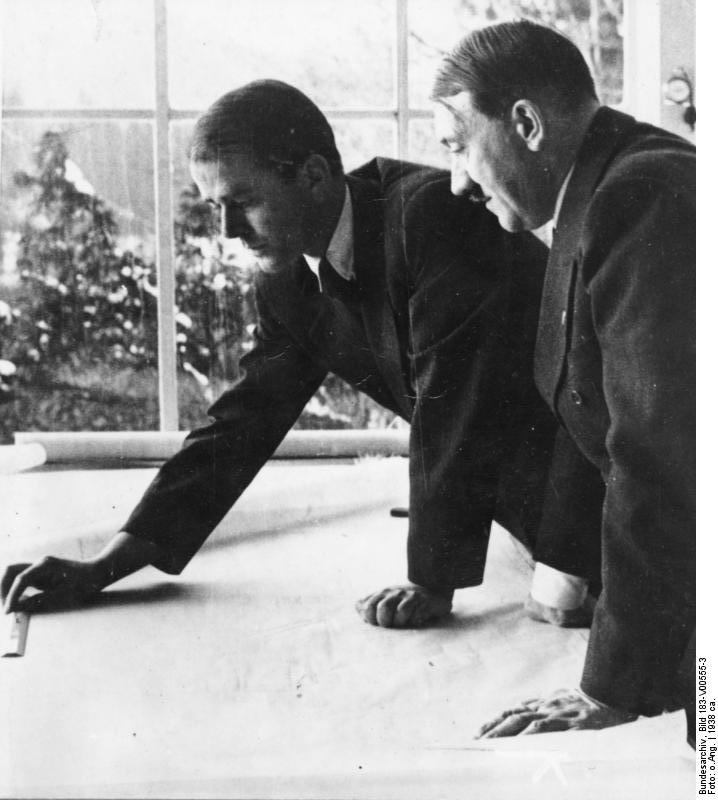 Albert Speer and Adolf Hitler bent over the construction plans in Speer's atelier Source: Bundesarchiv, Bild 183-V00555-3 / CC-BY-SA 3.0.
Albert Speer and Adolf Hitler bent over the construction plans in Speer's atelier Source: Bundesarchiv, Bild 183-V00555-3 / CC-BY-SA 3.0.Important guests
Many international discussions with Hitler took place at the Obersalzberg. In this way, a famous member of British parliament, David Lloyd George, visited Hitler on 4 September 1936. Hitler had written about Lloyd George, who had been Prime Minister of Great Britain during the Great War, with a lot of respect in Mein Kampf. He visited the Berghof in order to, as he said himself, study Hitler's social system and his solution to unemployment. But obviously, they also talked about the Great War and the German-British relations. After this meeting, Lloyd George is supposed to have said about Hitler that he was a born leader who had the will to solve the social problems in his country. This sympathy for Hitler in Great Britain wasn't restricted to Lloyd George. In 1937, the Duke and Duchess of Windsor came to the Berghof. The Duke was the former king of Engeland, Edward VIII. He had relinquished the throne because of his choice of partner. Edward is supposed to have had a certain sympathy for national socialism. Hitler presumed, in any case, that Edward could have been the man with whom he could have made a pact with Great Britain. Eva Braun was not allowed to appear during the visit of the Roval Highnesses, she remained in her bedroom during the visit.
In November of the same year, Lord Halifax, the later British Foreign Minister, came to the mountain in Bavaria. He had been invited by Göring to visit an exhibition about hunting. In the same time that Hitler's wish to annex parts of Czechoslovakia was an international discussion, Lord Halifax came to the Berghof for a talk with Hitler without new proposals on the matter. The discussion initially wasn't to Hitler's liking. But unplannedly, Halifax started about the situation in Austria and Czechoslovakia so that Hitler could clarify his claims on these territories and to point at the suppressed Sudeten Germans. Halifax, without approval of parliament, could not promise a thing. His analysis in hindsight was that Hitler would not take military action.
On 12 February,1938, the Austrian chancellor Schuschnigg came to the Berghof because tensions rose in Austria through action of Austrian nazis. A raging Hitler heavily pressured Schuschnigg and had him sign an ultimatum. This meant that the Austrian government would be taken over by the nazis. Schuschnigg signed, but he received a few days to present the treaty to the government. After a period of heavy pressure on Austria, German troops invaded the country on 12 May 1938 during the so- called Anschluss.
Konrad Henlein was the leader of the Sudeten Germans in Czechoslovakia, a party that listened to Hitler more and more as Hitler's wish to annex the country grew stronger. While in 1938, the Czechs had been put under great pressure, Hitler wanted that members of Henlein's party would provoke incidents, so that a reaction of Germany would seem necessary. On 2 September, Henlein came to the Obersalzberg, but Hitler didn't say anything about a possible invasion of Czechslovakia. Right after the visit, Hitler decided to invade the country on 1 October.The British, however, were to spoil this plan. Two weeks after Henlein's visit, Neville Chamberlain came to the Obersalzberg. Hitler and Chamberlain talked with each other in private, but Hitler didn't succeed to pressure Chamberlain with his emotional outbursts with which he sometimes was succesful. Chamberlain interrupted Hitler and indicated that he did not understand what he was doing on the Obersalzberg if Hitler's decision to attack Czechoslovakia had already been made. Hitler climbed down, with the result that additional talks were held at Bad Godesberg and on an international conference in Munich. Hitler, in the end, got what he wanted. Sudeten-Germany was added to Germany officially on 29 September, 1938. But in January 1939, Hitler again went to the Obersalzberg in order to think about his foreign policy. And that meant bad things for Czechoslovakia. In March, 1939, the Germans annexed the rest of Czechoslovakia.
The Polish question was prepared partly at the Berghof. East Prussia and Danzig were separated from the rest of Germany by the Treaty of Versailles. This was known as the Polish corridor.That was not to the liking of Hitler. He therefore invited the Polish foreign Minister, Joseph Beck, to come and talk about the matter. Strangely enough Hitler behaved very polite. He proposed a deal that meant that Poland would get a part of Czechoslovakia if Germany would receive back Danzig and that there would come a corridor to east Prussia. Germany and Poland would then agree on the tactic to be followed towards the Soviet Union. Also both nations would cooperate to drive the Jews from Poland. Because Beck had just established good ties with the Soviet Union, he did not agree with Hitlers proposals. It would not be appreciated in the Soviet Union if Beck would make far reaching agreements with the Germans. He obviously did not want to risk his good ties with the Soviet Union.
In order to keep the West out of the conflict with Poland, the High Commissioner for the League of Nations in Danzig, Carl Burckhardt, was present on the Obersalzberg on 11 August,1939. He met Hitler in the Kehlsteinhaus because this was an excellent place to impress people. Hitler threatened to invade Poland directly if there would be the slightest provocation, but he said that if the Poles would leave Danzig, he would not have to wage war unconditionally.This message Burckhart took with him to the French and British, who didn't do much with it. A day later, count Galeazzo Ciano, the son-in-law of Benito Mussolini, also came to the Berghof because the Italian dictator wanted to prevent the impending war. Italy didn't want and couldn't participate in such a war because her armed forces were not ready. Ciano put this forward, but Hitler explained that he thought that France and Great Britain wouldn't get involved also this time. Ciano understood that Hitler headed for war and passed this on to Mussolini.
The non- agression pact between Germany and the Soviet Union found its basis in a telegram from Hitler to Stalin. On 21 August 1939, during supper in Hitler's villa on the Obersalzberg, Hitler received a favorable reaction from Stalin. Foreign Minister, Joachim von Ribbentrop could come to Moscow to sign a treaty.Two days later, von Ribbentrop was in Moscow. Hitler still remained on the Obersalzberg. At night at 2:00 a.m., von Ribbentrop called with the statement that the treaty was a fact. The strange treaty between countries that were each other's archenemies was presented as a great succes but, as we know, it didn't stand long.
When Hitler was present again at the Obersalzberg after the invasion of western Europe, the mountain had been transformed into a 'Führerhauptquartier' because of the war. At that moment, mainly the war against Great Britain was on the program. An invasion of Engeland still seemed to be a serious possibility, but Hitler also turned out to have ideas about an invasion of the Soviet Union. In the army command, a war on two fronts had long been non negotionable. Hitler,however, had a conversation in July 1940 at the Berghof with general Alfred Jodl, member of the Supreme Command of the Wehrmacht, about the possibility to invade the Soviet-Union in the autumn of 1940. Jodl indicated that it was impossible, on such a short notice, to gather enough troops. The feasibility of such an invasion was further investigated in strict secret. Still, a large number of people in the army knew about the fact that the Wehrmacht had operational plans for an invasion at the ready.
On 31 July, a meeting from the military top took place at the Berghof. Once again, an invasion of Great Britain was discussed. Hitler proposed to first estimate the effects of the bombing of British cities. If these were sufficient, an invasion could take place. If not, it would be the turn of the Soviet Union. Because when the Germans could beat the Soviet Union, the British would know that they wouldn't stand a chance. The fact that Hitler quite underestimated the Soviets with this assumption would later become clear. The bombing of Great Britain got under way on 13 August, but they turned out to be less successful than anticipated. The British responded on 25 August, 1940 with their first bombardment of Berlin. The plans for an invasion of Great Britain were taken back and in September, Hitler postponed the invasion indefinitely.
King Boris of Bulgary came to the Berghof on 18 November, for a meeting with Hitler. The Soviet-Union wanted a treaty with Bulgary, but Hitler wanted to use the country as a basis of operations for his attack on the Soviet-Union. Although king Boris admired Hitler, he would not allow German troops on Bulgarian soil initially.They would only come in March,1941. On 19 November 1940, king Leopold of Belgium visited. He tried to save the royal house, wanted that Belgium remained independent and asked for relief from a number of German measures. Hitler did not go into this.
Also in 1941, Hitler received a number of important foreign guests on the Obersalzberg, like Prime Minister Bogdan Filoff from Bulgary, general Antonescu from Rumania, Mussolini, the Japanese ambassador Heroshi Oshima and Ante Pavelic, the fascist leader of Croatia. Hereafter, the frequency of this kind of visits to the Obersalzberg got lower and lower. Hitler spent increasingly more time in his 'Führerhauptquartier', the Wolfsschanze, in eastern Prussia, in order to coordinate the war with the Soviet Union. He used the nearby castle Klessheim near Salzburg on a regular basis for discussions with foreign allies.
Definitielijst
- Berghof
- A villa hidden deep in the Alps built at the top of the Obersalzberg near Berchtesgaden. This villa was property of Hitler and centre of the ”Alpenfestung”. The villa has an enormous complex of tunnels with a length of nearly 11 km. From the Berghof the Third Reich was ruled by Hitler and his close companions. Eva Braun, Hitler’s companion, spent a lot of time there.
- invasion
- Armed incursion.
- Jews
- Middle Eastern people with own religion that lived in Palestine. They distinguished themselves by their strong monotheism and the strict observance of the Law and tradition. During World War 2 the Jewish people were ruthlessly persecuted and annihilated by the German Nazis. . An estimated 6,000,000 Jews were exterminated.
- League of Nations
- International league of Nations for cooperation and security (1920 – 1941). The League was located in Geneva, in neutral Switzerland. During the 1930s the league of nations could do little against aggressive behaviour of Japan, Manchuria, Italy, Abyssinia and Hitler. The league of nations was in fact the predecessor of the United Nations.
- Mein Kampf
- “My Struggle”. Book written by Adolf Hitler, outlining the principles of National Socialism.
- national socialism
- A political ideology drawn up by Hitler based on the superiority of the German race, the leader principle and fierce nationalism that was fed by the hard Peace of Versailles. National socialism was anti-democratic and racist. The doctrine was elaborated in Mein Kampf and organised in the NSDAP. From 1933 to 1945 National socialism was the basis of totalitarian Germany.
- socialism
- Political ideology aiming at slight or no class differences. Means of production are owned by the state. Evolved as a response to capitalism. Karl Marx tried to substantiate socialism scientific.
- Soviet Union
- Soviet Russia, alternative name for the USSR.
- Sudeten Germans
- Name for over 3,000,000 Germans living near the border of Czechoslovakia until 1945.
- Wehrmacht
- German armed military forces, divided in ground forces, air force and navy.
- Wolfsschanze
- Headquarters of Adolf Hitler in East Prussia.
Images
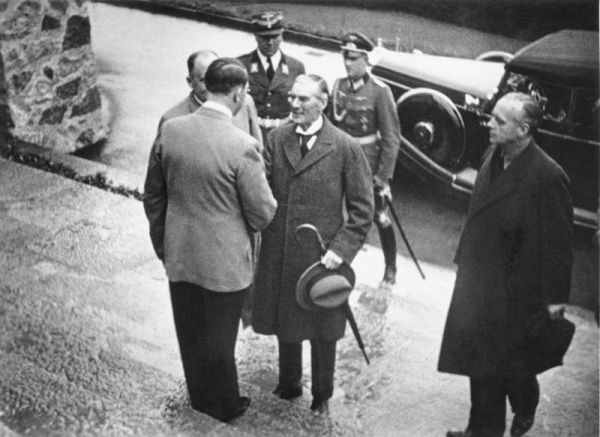 Hitler receives Chamberlain on the stairs in front of the Berghof Source: Bundesarchiv, Bild 183-H12478 / CC-BY-SA 3.0.
Hitler receives Chamberlain on the stairs in front of the Berghof Source: Bundesarchiv, Bild 183-H12478 / CC-BY-SA 3.0.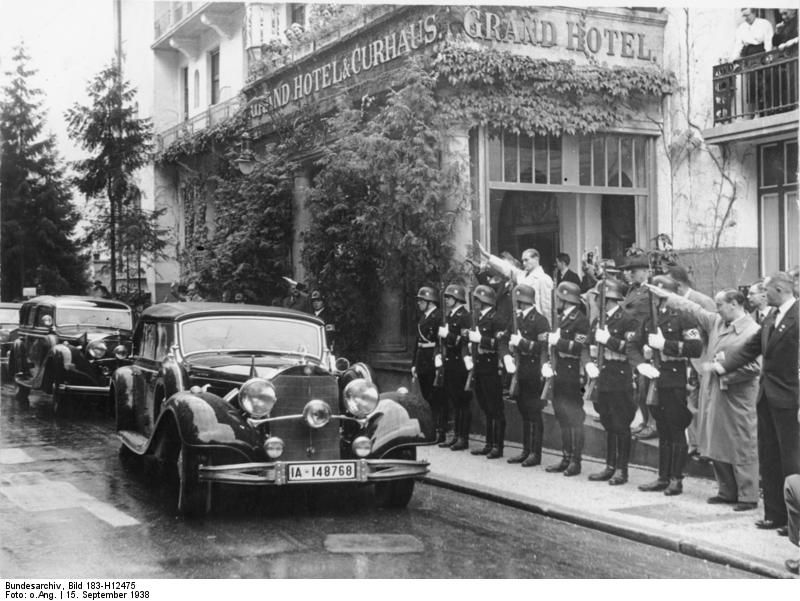 Chamberlain leaves Berchtesgaden after his visit to Adolf Hitler Source: Bundesarchiv, Bild 183-H12475 / CC-BY-SA 3.0.
Chamberlain leaves Berchtesgaden after his visit to Adolf Hitler Source: Bundesarchiv, Bild 183-H12475 / CC-BY-SA 3.0.A day at the Berghof
Around 1935, Hitler led a fairly structured life.At 10:00 a.m., for instance, the first discussions with the staff or nazi bosses began. These lasted until 14:00 p.m.Only after that there was lunch.This steady order of the day Hitler seems to have dropped, certainly when he was at the Obersalzberg. In the Berghof, Hitler often only appeared for lunch.In the afternoon he would walk and in the evening he would watch films.Thus says Fritz Wiedemann, adjutant of Hitler. Ian Kershaw says on this subject that Hitler went back to the way of life that had pleased him in Linz and Vienna.
The days at the Berghof mostly ran their own monotonous course, which was annoying for the frequent visitors. Hitler went to sleep only late at night and in the morning he would mostly sleep until 11a.m. Until that time everyone on the Berghof kept quiet and even labourers on the mountain tried to make as little noise as possible. Only with urgent matters was Hitler awakened early by one of his adjutants. For instance at Sunday morning, 11 May 1941 when the adjutant of Rudolf Hess brought the message that Hess had flown to Great Britain in order to negotiate for peace. On the morning of the invasion in Normandy on 6 June 1944, Hitler was not awakened, because it was suspected that this was a diversionary attack, as had been the case before.
On a quiet morning, Hitler would check the post after which he prepared for breakfast.After breakfast he disappeared in the conference room ( the room with the large window) in order to read reports and take decisions.Often, high ranking military personnel would report who waited for a conversation with the Führer. Famous are the film images from the giant terrace of the Berghof, on which private guests and military personnel hang around in the sun, waiting for Hitler. Albert Speer, Hitler's favorite architect, told about this later: "The atmosphere was very informal, but also outspokenly boring and without any variation. In the long run, we had not much to say to one another."
When Hitler was ready with his work, he came to the guests that had entertained themselves while waiting in another room,or on the terrace when the weather was good. Thereafter, lunch was served and the guests would go to the dining room that was in an adjacent wing of the Berghof.
After the meal, a walk towards the tea house on the Mooslahnerkopf followed. This was a small tea house, half an hour walking downward of the Berghof. Hitler had the house built himself on a place with a beautiful view of the environment. In order to enjoy this even better, a viewpoint was created.In the house, coffee and tea but also alcohol could be consumed.Because Hitler liked sweet things, one could use all kinds of cake. Here also, Hitler would sometimes fall into one of his famous lengthy monologues.Often, the guests had heard the stories several times. Sometimes Hitler would fall asleep after such a monologue.Eva Braun waked him up when it was time to return to the Berghof. Mostly they returned with a number of cars.
Once arrived at the Berghof, Hitler often withdrew for a while to reappear for dinner in the conference room. The tendance, seating arrangement and service were always strictly arranged, because Hitler insisted on that.Hitler was in the middle, Eva Braun sat to the left of him and the most important guest was opposite them.Hitler barely drank alcohol and if and when he drank, it was mostly beer with an alcohol percentage lowered especially for him.He also was a vegetarian since the beginning of the thirties. His guests were allowed to drink wine and beer and they also ate meat.But Hitler, who was often speaking constantly, could not refrain from pondering on various butcher rituals.Still, most of the guests would eat on unannoyed because they were used to these stories. After dinner, a number of discussions with the military or politicians followed. The other guests would go to another room where Hitler would join them after the discussion. After this, the evening program began.
The evening hours were spent in the large room. Often, Hitler would talk in long monologues until deep in the night. Especially about memories and plans for the future and not seldom for a less than interested audience. But also films were watched. Behind a tapestry there was a folded screen. When Hitler wanted to see a film, he pulled away the tapestry. Especially non-political foreign films were popular under the guests. Further there was a piano on which some guests would play. Or sometimes records were being played. Hitler's favorite composers were Bruckner, Beethoven, Richard Strauß, Hugo Wolf, Brahms, Schubert, Schumann and Wagner. Until deep in the night the guests would sit together. Group talks were seldom held because the room was very big and the placing of the furniture rendered an easy conversation difficult. The discussions were often about insignificant matters. Albert Speer would later remark on the communal life at the Obersalzberg that in his memory, a striking emptiness prevailed. Of the hundreds of tea discussions about theater, film, operette and the family life of the guests, obviously little had stuck. Hitler barely talked about the Jews, concentration camps or about political enemies.
Mostly an evening at the Berghof would be spent in dull harmony, but now and then someone asked a difficult question. A well-known incident occured around Henriette von Schirach, the daughter of Heinrich Hoffmann.She already knew Hitler from the twenties onward,when she was still a little girl and Hitler would frequent her house or would come in the store of her father. She thought that she could have contact with Hitler in a fairly relaxed way.As it seems, in the beginning of 1943, she went way too far. During a stay at the Berghof she addressed Hitler about the deportation of Jewish women that she had witnessed in Amsterdam.Hitler raged and said according to Von Schirach that the Dutch Jewesses were none of her business."You must learn to hate...", were his words. Von Schirach let Hitler yell and left for her sleeping room.Her husband, Baldur, is supposed to have been at the cafetaria to smoke a pipe.After she had briefed him, they disappeared to the valley at 05:00 a.m in the morning in a small sports car. Notwithstanding the fact that there are several versions of the story it is good to mention that Baldur von Schirach was responsible for the deportation of 60,000 Jews from Vienna and that he was condemned to 20 years of prison in Nuremberg. Henriette must have known about this, certainly in this stage of the war, when she adopted this story in her book about this period far after the war.
The normal evenings at the Berghof ended mostly after Eva Braun went upstairs at 02:00 a.m.Hitler would disappear quickly after that. The guests would drink somewhat after that and would return to their own homes at the mountain or to their rooms at the Berghof.
Definitielijst
- Berghof
- A villa hidden deep in the Alps built at the top of the Obersalzberg near Berchtesgaden. This villa was property of Hitler and centre of the ”Alpenfestung”. The villa has an enormous complex of tunnels with a length of nearly 11 km. From the Berghof the Third Reich was ruled by Hitler and his close companions. Eva Braun, Hitler’s companion, spent a lot of time there.
- Führer
- German word for leader. During his reign of power Adolf Hitler was Führer of Nazi Germany.
- invasion
- Armed incursion.
- Jews
- Middle Eastern people with own religion that lived in Palestine. They distinguished themselves by their strong monotheism and the strict observance of the Law and tradition. During World War 2 the Jewish people were ruthlessly persecuted and annihilated by the German Nazis. . An estimated 6,000,000 Jews were exterminated.
- nazi
- Abbreviation of a national socialist.
Images
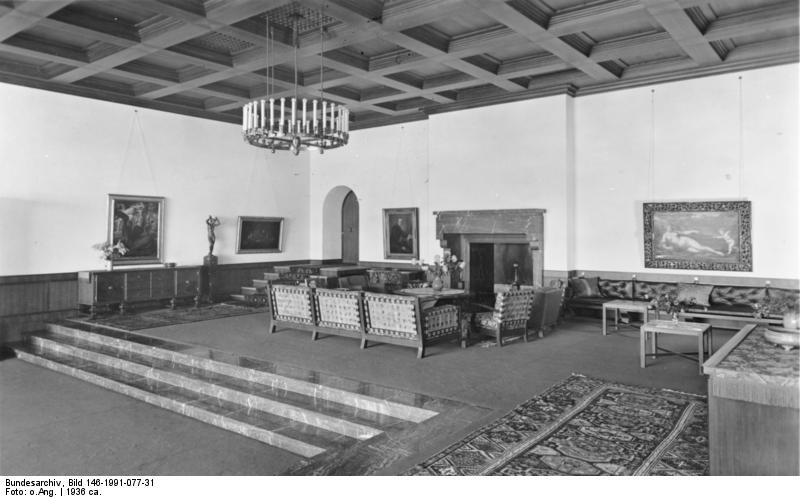 The large room of the Berghof.Hitler's guests would often remain here until deep in the night Source: Bundesarchiv, Bild 146-1991-077-31 / CC-BY-SA 3.0.
The large room of the Berghof.Hitler's guests would often remain here until deep in the night Source: Bundesarchiv, Bild 146-1991-077-31 / CC-BY-SA 3.0.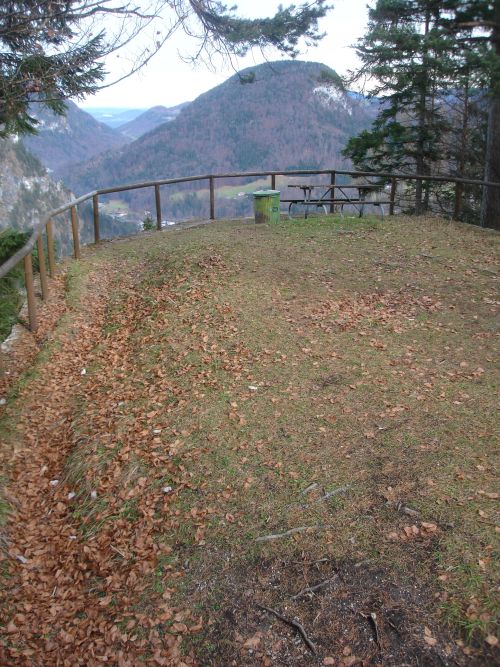 The viewpoint on the Mooslahnerkopf was the end of the regular stroll of Hitler and his companions at the Obersalzberg Source: Sjoerd de Boer.
The viewpoint on the Mooslahnerkopf was the end of the regular stroll of Hitler and his companions at the Obersalzberg Source: Sjoerd de Boer. Adolf Hitler and Eva Braun with their dogs on the terrace of the Berghof Source: Bundesarchiv, B 145 Bild-F051673-0059 / CC-BY-SA.
Adolf Hitler and Eva Braun with their dogs on the terrace of the Berghof Source: Bundesarchiv, B 145 Bild-F051673-0059 / CC-BY-SA.Hitler leaves the Obersalzberg
While on 26 May,1944 it was long clear that the war was a thing that went worse and worse for the Germans, an important meeting of generals and other high-ranking officers took place on the Obersalzberg. Hitler addressed them with the aim of strengthening the solidarity of the army leaders. He primarily spoke of matters concerning the races.The superior German people would have to eradicate the Jews because otherwise the roles would be turned around; the Jews would then eradicate the Germans.
Not long after that, on 14 June 1944, Hitler left the Obersalzberg for the last time, in order to lead the fight against the Soviet Union again from the Wolfsschanze, the wolf's lair. Following this, he left eastern Prussia for Berlin in November 1944. He would only leave the city for an incidental front visit and for the Ardennes offensive.
But while Adolf Hitler and Eva Braun awaited the end of the war in their bunker in Berlin, Hermann Göring was still at the Obersalzberg and also the family of Martin Bormann remained there. Bormann himself was mostly in Berlin, just like for instance Dr. Theodor Morell, who had to remain with Hitler until just before his suicide. On the last birthday of Hitler, on 20 April 1945, the two secretaries Johanna Wolf and Christa Schroeder left the heavily shelled bunker, on orders of Hitler, to go to the Obersalzberg.They departed to the south on an airplane. When they arrived, after a perillous flight, at the Berghof the mother and the heavily pregnant sister of Eva Braun and her friend Herta Schneider were still there, together with the adjutant Jesko von Putkammer. Dr. Morell, Hitler's court physician, also had fled the bunker in Berlin alive and he arrived a couple of days later. But he would depart rather fast. Albert Bormann, the brother of Martin Bormann, who had a high function within the NSDAP and who was a member of the Reichstag, had also left Berlin and he stayed in the hotel Berchtesgadener Hof in Berchtesgaden. Now and then he would emerge in order to replenish the stock in the hotel with the food and drinks with which the bunkers on the mountain had been crammed.
Albert Bormann reported on 23 April 1945 in Göring's manor on the mountain.On orders of Göring, he had to destroy all kinds of important documents. Albert Bormann is supposed to have had the impression that Göring already considered himself to be the successor of Hitler.That also showed from what had happened in the evening.That evening, the Berghof was surrounded by SS men. No one was allowed in or out. It was not very clear to those present why this happened, but Göring turned out to be arrested because he had sent a telegram to Hitler that would later become very famous. In the telegram, he asked if Hitler was still capable of taking decisions independently. If that would prove to be not the case, Göring would take over power. Martin Bormann, who was with Hitler, interpreted this message as a coup d'etat. Göring was arrested and locked up in a castle in Austria. There he was liberated by soldiers of the Luftwaffe, but he decided to surrender to the Americans, who arrested him in May, 1945, in the Austrian region of Pinzgau.
Definitielijst
- Ardennes offensive
- Battle of the Bulge, “Von Rundstedt offensive“ or “die Wacht am Rhein“. Final large German offensive in the west from December 1944 through January 1945.
- Berghof
- A villa hidden deep in the Alps built at the top of the Obersalzberg near Berchtesgaden. This villa was property of Hitler and centre of the ”Alpenfestung”. The villa has an enormous complex of tunnels with a length of nearly 11 km. From the Berghof the Third Reich was ruled by Hitler and his close companions. Eva Braun, Hitler’s companion, spent a lot of time there.
- Jews
- Middle Eastern people with own religion that lived in Palestine. They distinguished themselves by their strong monotheism and the strict observance of the Law and tradition. During World War 2 the Jewish people were ruthlessly persecuted and annihilated by the German Nazis. . An estimated 6,000,000 Jews were exterminated.
- Luftwaffe
- German air force.
- offensive
- Attack on a smaller or larger scale.
- Soviet Union
- Soviet Russia, alternative name for the USSR.
- Wolfsschanze
- Headquarters of Adolf Hitler in East Prussia.
The Alpine Fortress
Reichsführer-SS Heinrich Himmler considered the idea, in the beginning of 1944, to turn the Alps into a vast fortress. From this resistance nest, Germany could be liberated when the coalition between the United States and the Soviet Union would break. The idea was never seriously elaborated on, but the Germans did manage to divert the American advance to Berlin by feeding the Americans tales about the Alpine fortress. The American Secret Service took the suggestion of the Alpine fortress so seriously that they were almost disappointed when general George Patton could not confirm its existence.
Still there was a certain reality behind the idea. Hitler, as well as the army command, did not doubt the fact that Germany would be split in two. If the Germans could manage to defend both parts until a conflict between the Soviets and the Americans arose, Germany would still have a chance. If army groups from Italy, Austria and the west would concentrate in the south of Germany, Martin Bormann could take command there. The fact that there were other plans of resistance also proved from another initiative from Himmler, the action Werwolf. Himmler had SS-Obergruppenführer Hans-Adolf Prützman assemble commando units that were supposed to be busy with undergound activities behind enemy lines, like sabotage and ambushes and killings. Werwolf, however, was active in several regions in Germany and the resistance movement had little to do with the Alpine fortress in the south of the country. On 5 May,1945, the Werwolf actions were declared illegal by Grossadmiral Karl Dönitz, successor to Hitler. Franz Hofer, the Gauleiter of Tirol, is supposed to have had an elaborated plan, in 1944, for the defence of southern Germany at the end of the war. Because the chances of success for the Ardennes offensive were deemed higher, nothing was initially done with this plan. Only Goebbels saw bread in the suggestion of an impenetrable fastness in the south. He had the coworkers of the Propaganda Ministry spread rumours about this, so that the plan would have at least some influence on the morale of the people and would worry the enemy in the west.The Obersalzberg was a well defended holiday resort but not a well defended fortress. In times of war, the Berghof was appointed to Führerhauptquartier, but that went for every place where Hitler remained in war time for a longer time. The security, for instance, was organized as the Wolfsschanze in Eastern Prussia and the Felsennest in North Rhine- Westphalia: with three rings of security around the place where Hitler stayed and with an airfield in the vicinity. If it had been decided to really defend the Obersalzberg, this could have constituted a problem for the allies, but Hitler had never planned to flee to the Obersalzberg in the last weeks of his life. A true Alpine fortress therefore never came into existence.
Definitielijst
- Ardennes offensive
- Battle of the Bulge, “Von Rundstedt offensive“ or “die Wacht am Rhein“. Final large German offensive in the west from December 1944 through January 1945.
- Berghof
- A villa hidden deep in the Alps built at the top of the Obersalzberg near Berchtesgaden. This villa was property of Hitler and centre of the ”Alpenfestung”. The villa has an enormous complex of tunnels with a length of nearly 11 km. From the Berghof the Third Reich was ruled by Hitler and his close companions. Eva Braun, Hitler’s companion, spent a lot of time there.
- Gauleiter
- Leader and representative of the NSDAP of a Gau.
- offensive
- Attack on a smaller or larger scale.
- Propaganda
- Often misleading information used to gain support among supporters or to gain support. Often used to accomplish ideas and political goals.
- resistance
- Resistance against the enemy. Often also with armed resources.
- Soviet Union
- Soviet Russia, alternative name for the USSR.
- Wolfsschanze
- Headquarters of Adolf Hitler in East Prussia.
The destruction
On 25 April,1945 at around 09:30 a.m., air raid sirens sounded on the mountain. More than 300 American bombers flew in over the Hoher Göll, a mountain of 2,500 meters high that lies south of the Obersalzberg, on what is again the border between Germany and Austria. They came to bomb the so-called Alpine fortress. Everyone who was still on the mountain, like Eva Braun's sister and a number of secretaries, ran for cover in the bunkers under the buildings. Only at 14:30 p.m. could they leave the bunkers again. It turned out that all houses and buildings had been destroyed or heavily damaged. Of the Berghof, the walls still stood up, but all doors and windows were gone and inside not much was still intact. The Platterhof, the SS barracks, the house of Göring, the house of Bormann and many other buildings had changed into ruins.
Almost everyone in the bunkers that had survived, tried to flee. Greta Fegelein-Braun and Herta Schneider left for Garmisch.Those who did not have a place to go to remained in the bunker and used them as temporary homes. Hitler's adjudant Julius Schaub came from Berlin to the Obersalzberg in order to destroy all remaining papers, letters and documents of the Führer. Most of the material was burned on the terrace of the Berghof.When on 1 May it became known that Hitler had committed suicide a day before, the population of Berchtesgaden came to take a look at the Obersalzberg. Almost everyone had already left the mountain and no one interfered with the population when they started plundering the buildings and bunkers. The model farm Gutshof was emptied, during which also the animals were taken away. Also, the Platterhof was plundered. Especially the storage rooms of the bunkers, that were still filled with plenty of food and drinks, received many visitors. Görings wine cellar was also emptied. His collected artworks had already been retrieved and had, among others, been placed in a train in the village of Berchtesgaden. After the pillage a number of remaining SS men set the Berghof ablaze, after which they also disappeared. Secretary Schroeder, one of the last acquaintances that had stayed in the bunkers at the Berghof, temporarily joined Albert Bormann and a number of other acquaintances in the region.
The capture of the region Berchtesgaden was, for the allies, much easier than expected. The Obersalzberg did not turn out to be an Alpine fortress, so the bombardement had not been really meaningful. The most important nazis had long gone, even Göring was gone.
Definitielijst
- Berghof
- A villa hidden deep in the Alps built at the top of the Obersalzberg near Berchtesgaden. This villa was property of Hitler and centre of the ”Alpenfestung”. The villa has an enormous complex of tunnels with a length of nearly 11 km. From the Berghof the Third Reich was ruled by Hitler and his close companions. Eva Braun, Hitler’s companion, spent a lot of time there.
- Führer
- German word for leader. During his reign of power Adolf Hitler was Führer of Nazi Germany.
- raid
- Fast military raid in enemy territory
Images
The Obersalzberg in 2010
Directly after the end of the war, a stream of German visitors came to the Obersalzberg. The Americans, therefore, placed the area under their direct control rather quickly. The area was again cleared in 1951, but first the houses of Göring and Hitler were blown up and pulled down, because the Americans did not want that the place would turn into a pilgrimage site for nazis. On the symbolic date of 30 April, 1952 at 17:05 p.m. (exactly seven years after Hitler's suicide), the Berghof was blown up. The remnants were removed together with the houses of Bormann and Göring.The Platterhof was restored and rechristened into General Walker Hotel and was used by U.S. soldiers. Four years after the Americans left in 1996, the hotel was demolished. Near the parking place on the Obersalzberg, a small remnant of the hotel remains.
Except for some remnants and an entry to the bunker system that is difficult to get by, not much remains of Bormann's house. Of the villa with the swimming pool of Hermann Göring, certainly after the construction of the Intercontinental Resort on the 'Göringhill', nothing at all can be traced back. Both houses of Albert Speer, that lay a bit further, are still there.They are private property. Because the mountain still draws many tourists even now, the party chancellory of Bormann is rebuilt into a documentary centre about the past of the mountain. In the forest, near the parking place where, in the summer, the point of departure from the bus to the Kehlsteinhaus is, there are even some foundations of the Kampfhäusl, the small house where Hitler partially wrote Mein Kampf.
According to the documentary centre Obersalzberg, over 150,000 people visit the mountain annually. One of the most important attractions is the Kehlsteinhaus, that lies on the summit of the mountain Kehlstein mountain. The ruins of the small tea house on the Mooslahnerkopf lay in place until 2005. After this, they were removed. The view point that belonged to it, known of many historic pictures of Hitler, is still there. Also Hotel Zum Türken remains, as well as the Gutshof, where a golfclub resides now.
The bunkers of the Obersalzberg are accessible on two spots. Via the documentary centre, one can get to the personnel bunkers and the telephone exchange. In hotel Zum Türken there is also a bunker entry that is accessible for visitors. Here one can come near the rooms of Adolf Hitler, Eva Braun and Theodor Morell. The corridor to the rooms, however, was closed because there was danger of collapse of the corridor. Presumably the rooms have been made inaccessible, in order to avoid the rooms becoming a pilgrimage site for sympathizers of Hitler. Right after the war, there were even wedding ceremonies in the room of Hitler and Eva Braun. On the mountain there are several other exits of the bunker system, but mostly they are closed or made inaccessible in another way.
Whoever visits the old cemetery in the centre of the village of Berchtesgaden, finds the grave of Hitler's mentor, Dietrich Eckart, on a fairly prominent place. Eckhart died here after Hitler's failed attempt to seize power in Munich.The man that introduced Adolf Hitler to the region lies opposite of the fence of the graveyard where various commemoration stones for the young men that died on the various battlefields of World War Two are. Their bodies never were found.
Definitielijst
- Berghof
- A villa hidden deep in the Alps built at the top of the Obersalzberg near Berchtesgaden. This villa was property of Hitler and centre of the ”Alpenfestung”. The villa has an enormous complex of tunnels with a length of nearly 11 km. From the Berghof the Third Reich was ruled by Hitler and his close companions. Eva Braun, Hitler’s companion, spent a lot of time there.
- Mein Kampf
- “My Struggle”. Book written by Adolf Hitler, outlining the principles of National Socialism.
Images
Information
- Article by:
- Sjoerd de Boer
- Translated by:
- Peter ter Haar
- Published on:
- 29-05-2016
- Last edit on:
- 13-08-2016
- Feedback?
- Send it!
Related sights
Related books
Sources
- BESYMENSKI, L., De laatste notities van Martin Bormann, Elsevier, Amsterdam/Brussel, 1975.
- CAPELLE, H. VAN & BOVENKAMP, A.P. VAN DE, De Berghof, Verba, Hoevelaken, 2003.
- KERSHAW, I., Hitler - Hoogmoed 1889-1936, Het Spectrum, Utrecht, 2003.
- KERSHAW, I., Hitler - Vergelding 1936-1945, Het Spectrum, Utrecht, 2003.
- KOPLECK, M., Obersalzberg 1933-1945, Ch. Links Verlag, Berlijn, 2006.
- SCHIRACH, H. VON, Der Preis der Herrlichkeit, Herbig Verlagsbuchhandlung, München, 2003.
- SCHROEDER, C., Er war mein Chef, Herbig Verlagsbuchhandlung, München, 2004.
- SPEER, A., Erinnerungen, Ullstein Buchverlage, Berlijn, 2005.
- SPEER, A., Spandauer Tagebücher, Ullstein Buchverlag, Berlijn, 2005.
- TRAUDL, J., Tot het laatste uur, Tirion uitgevers, Baarn, 2002.
- WEINBERG, G., Hitler's second book, Enigma Books, New York, 2003.
